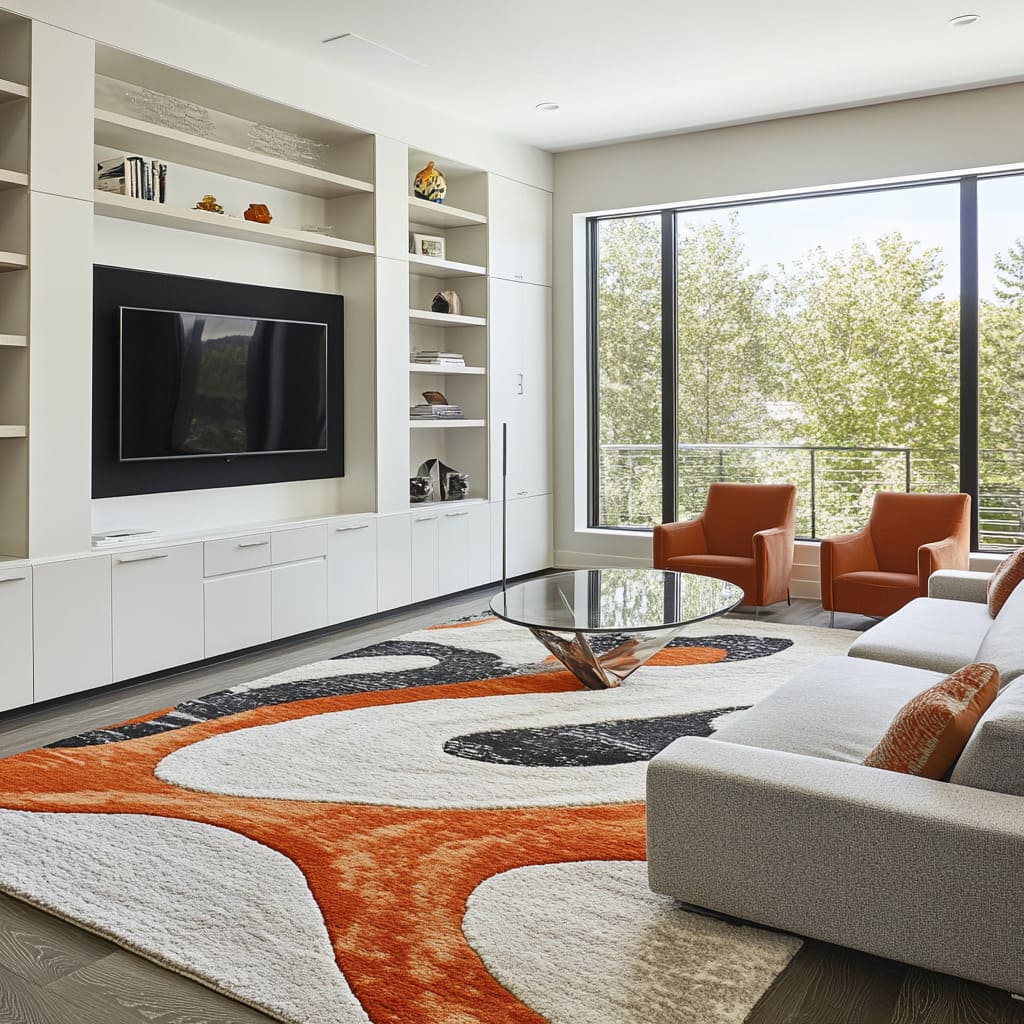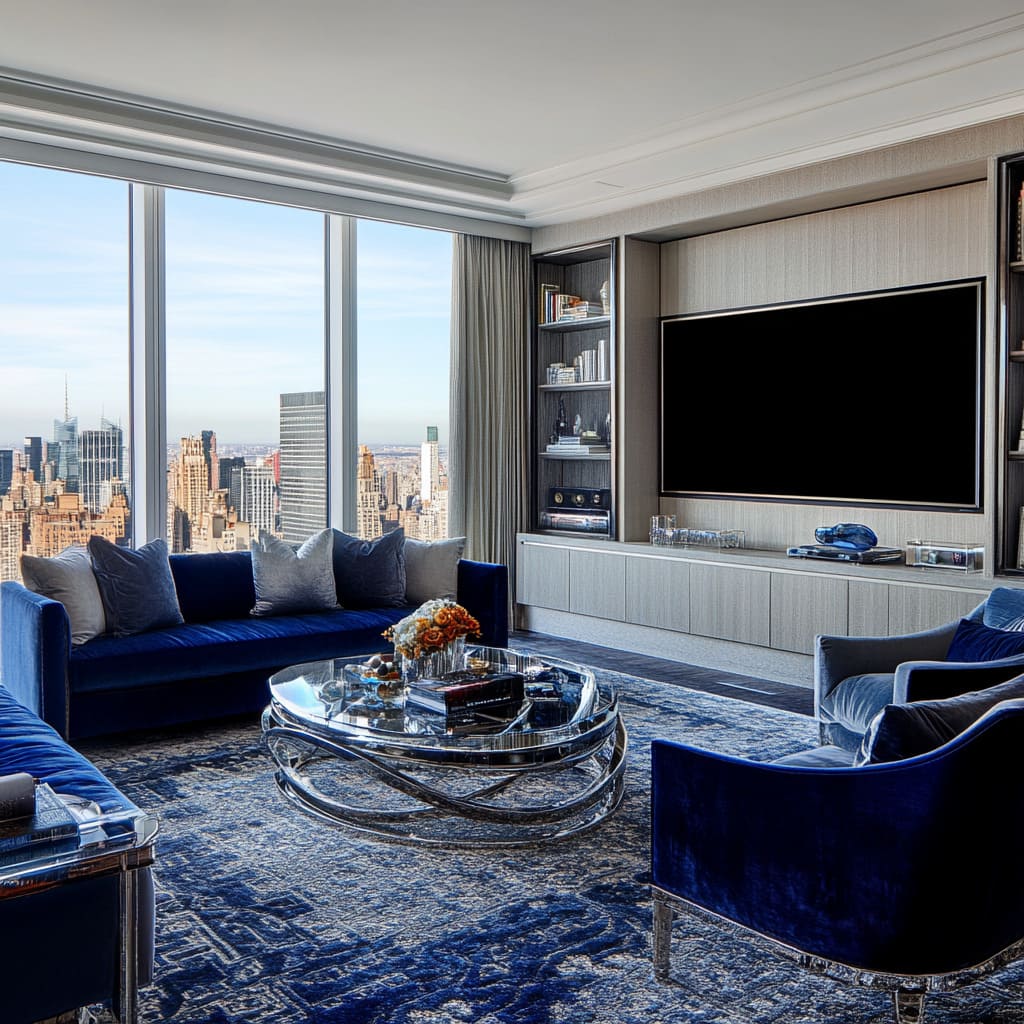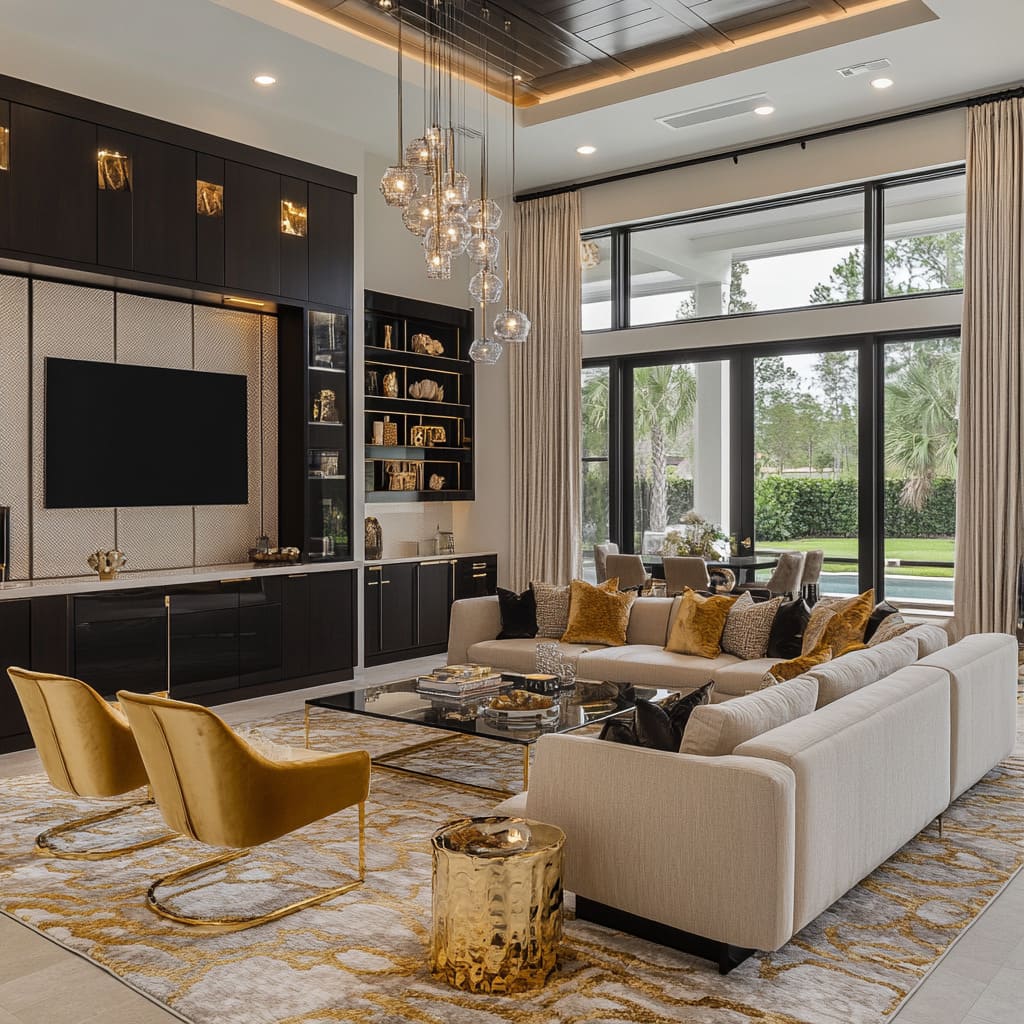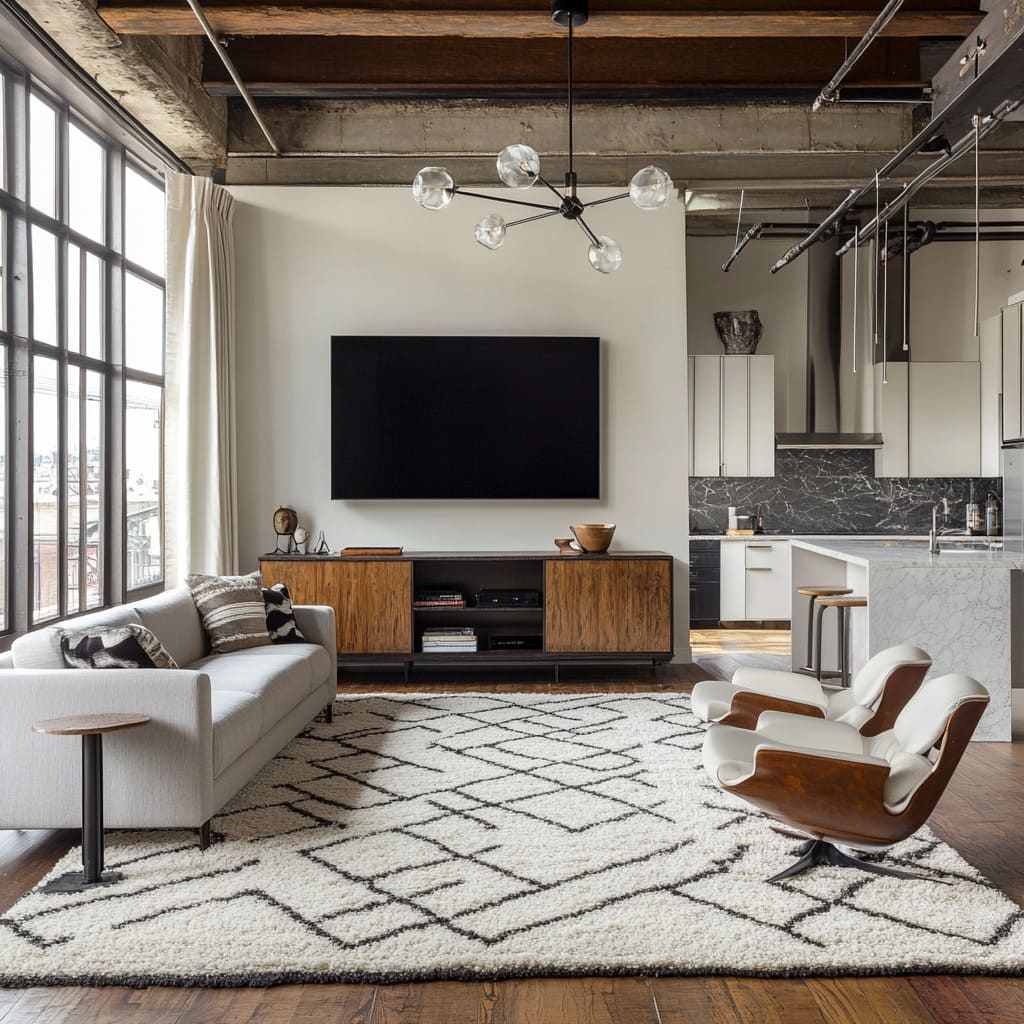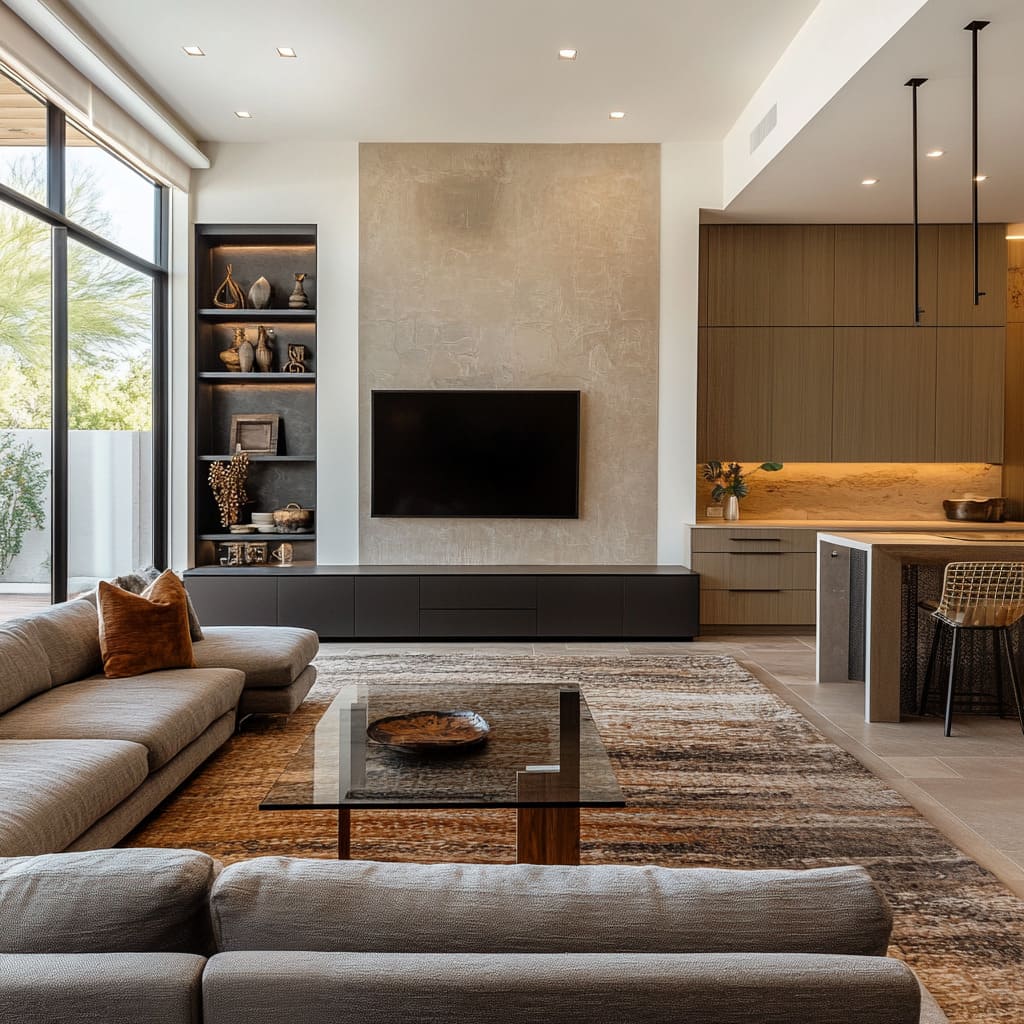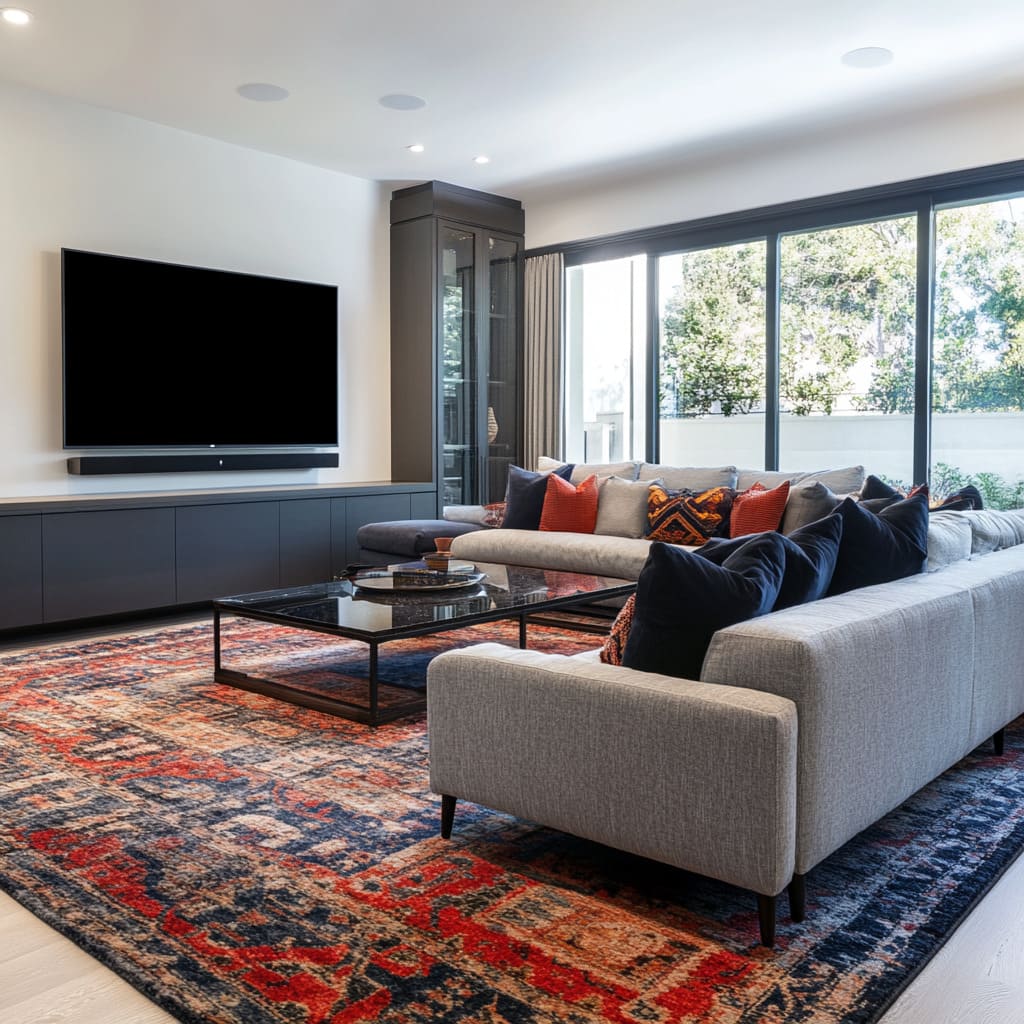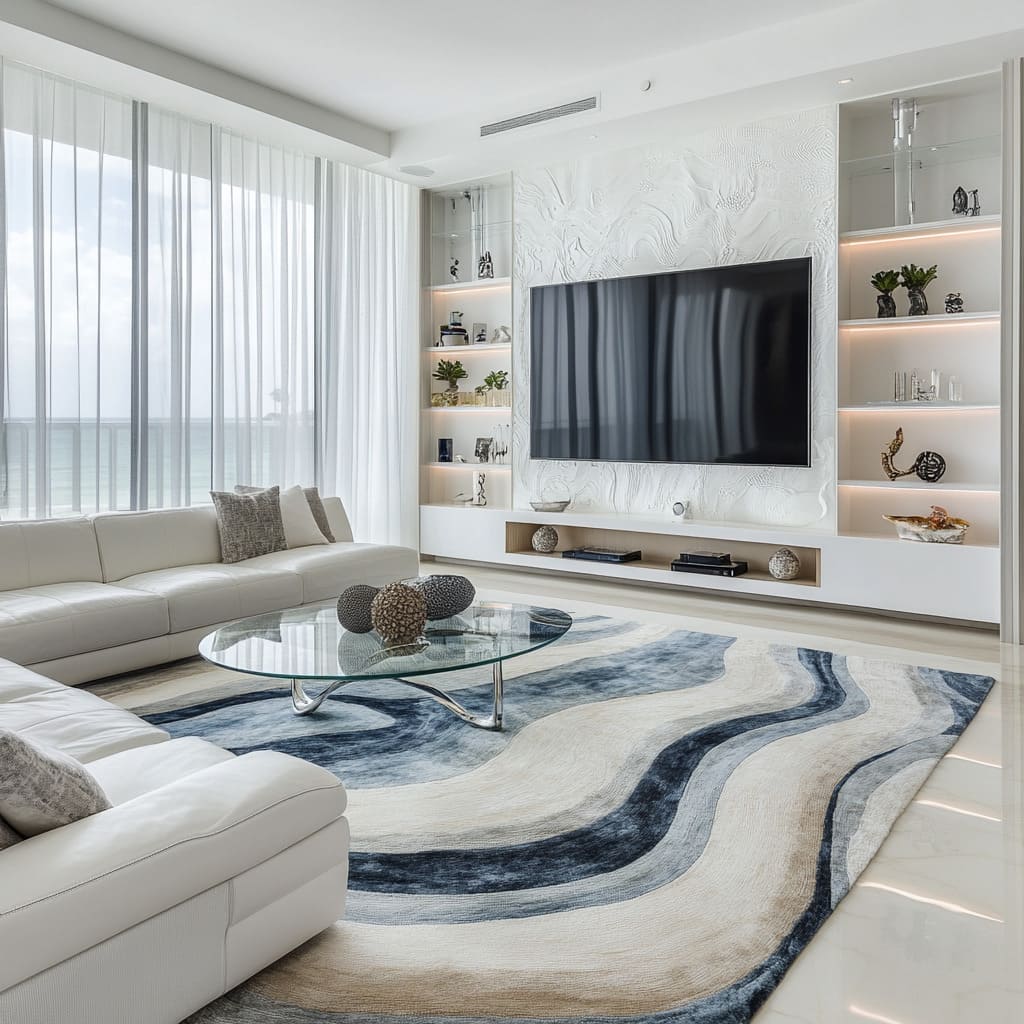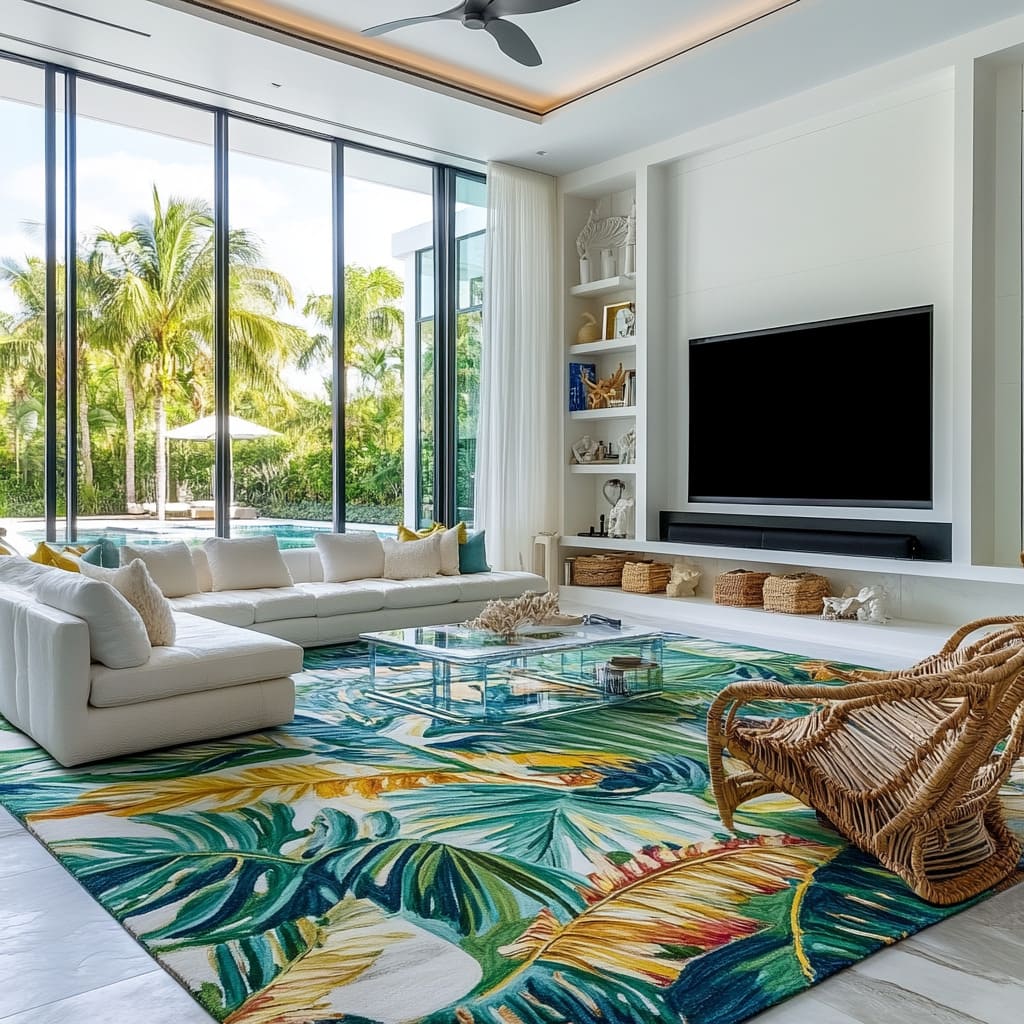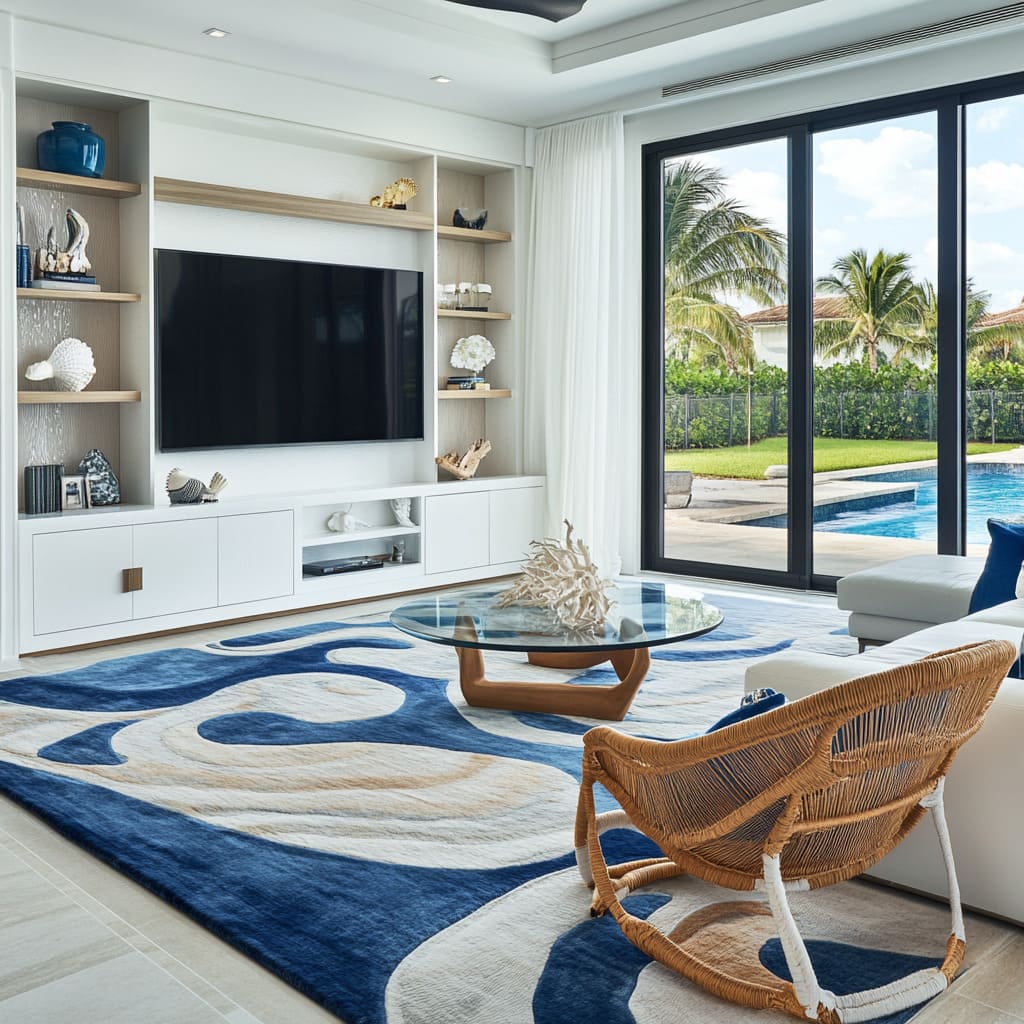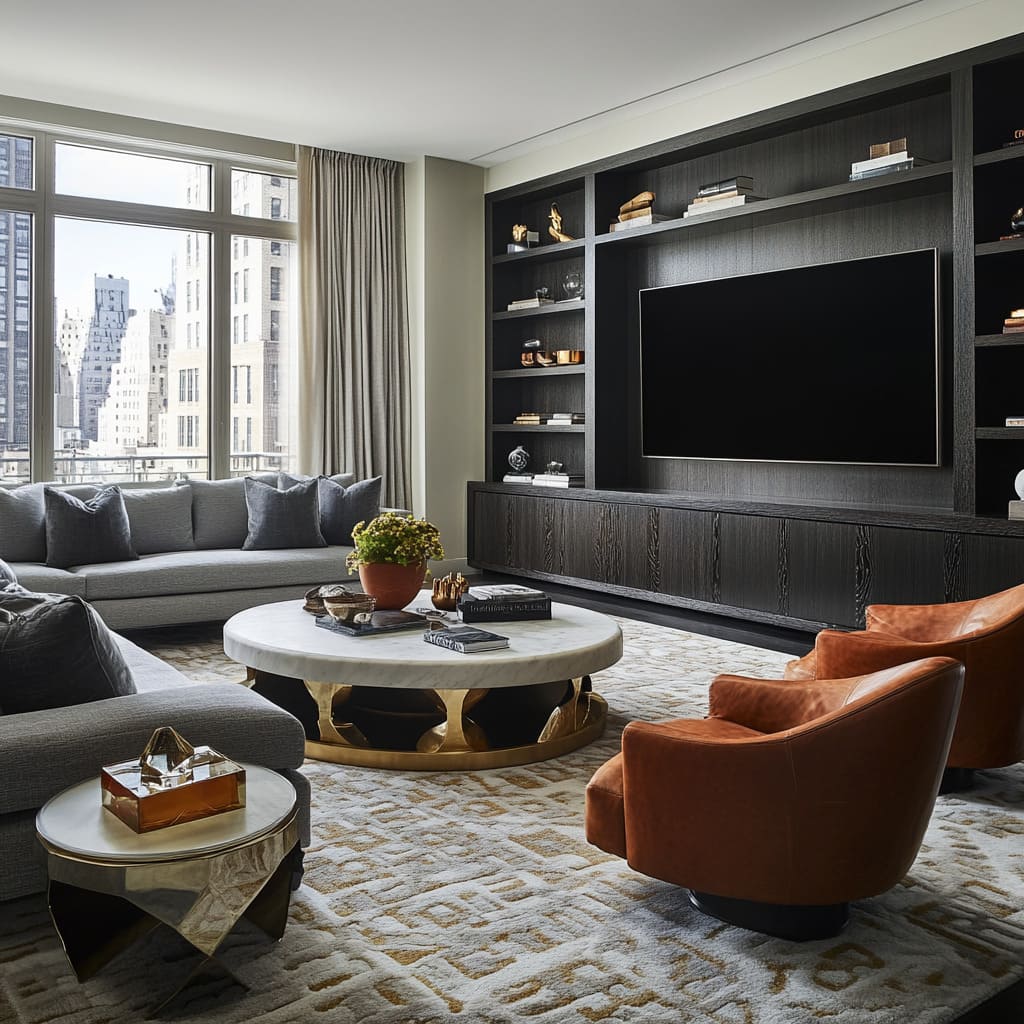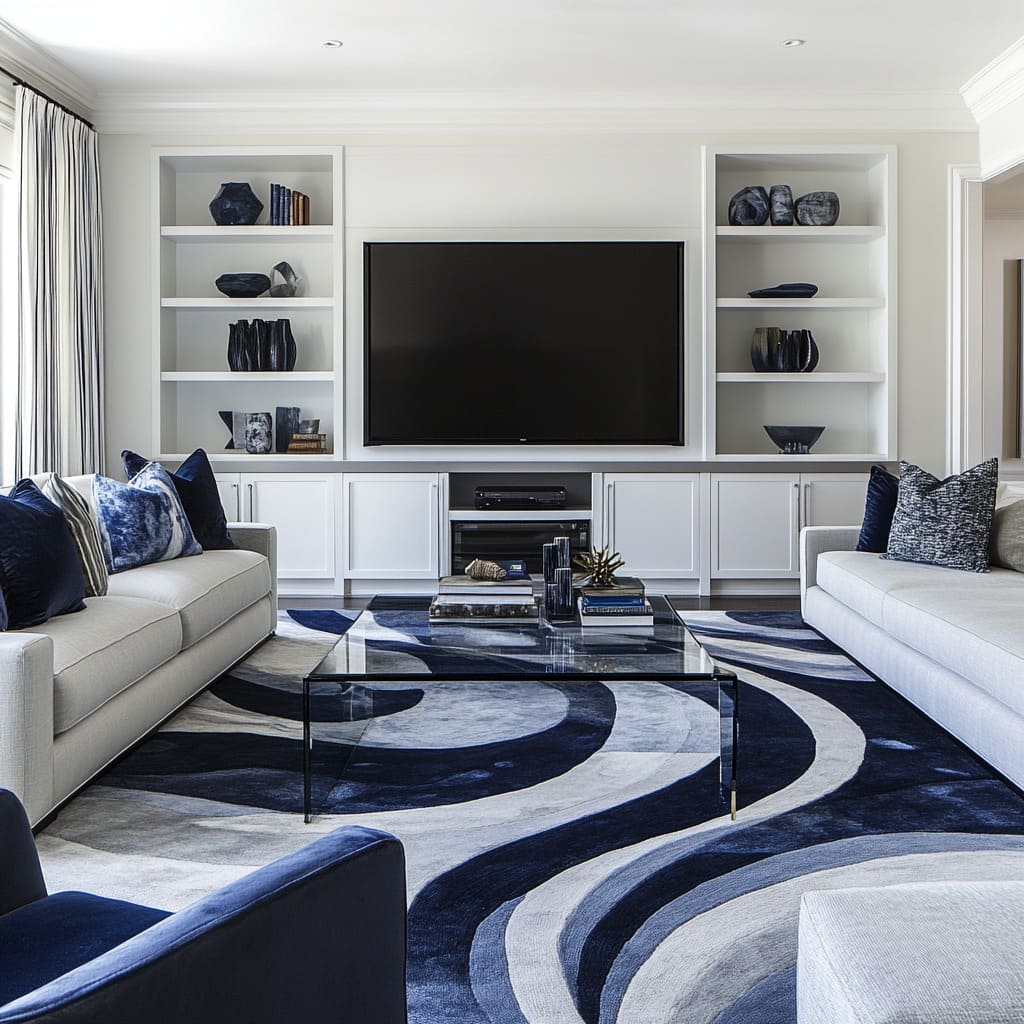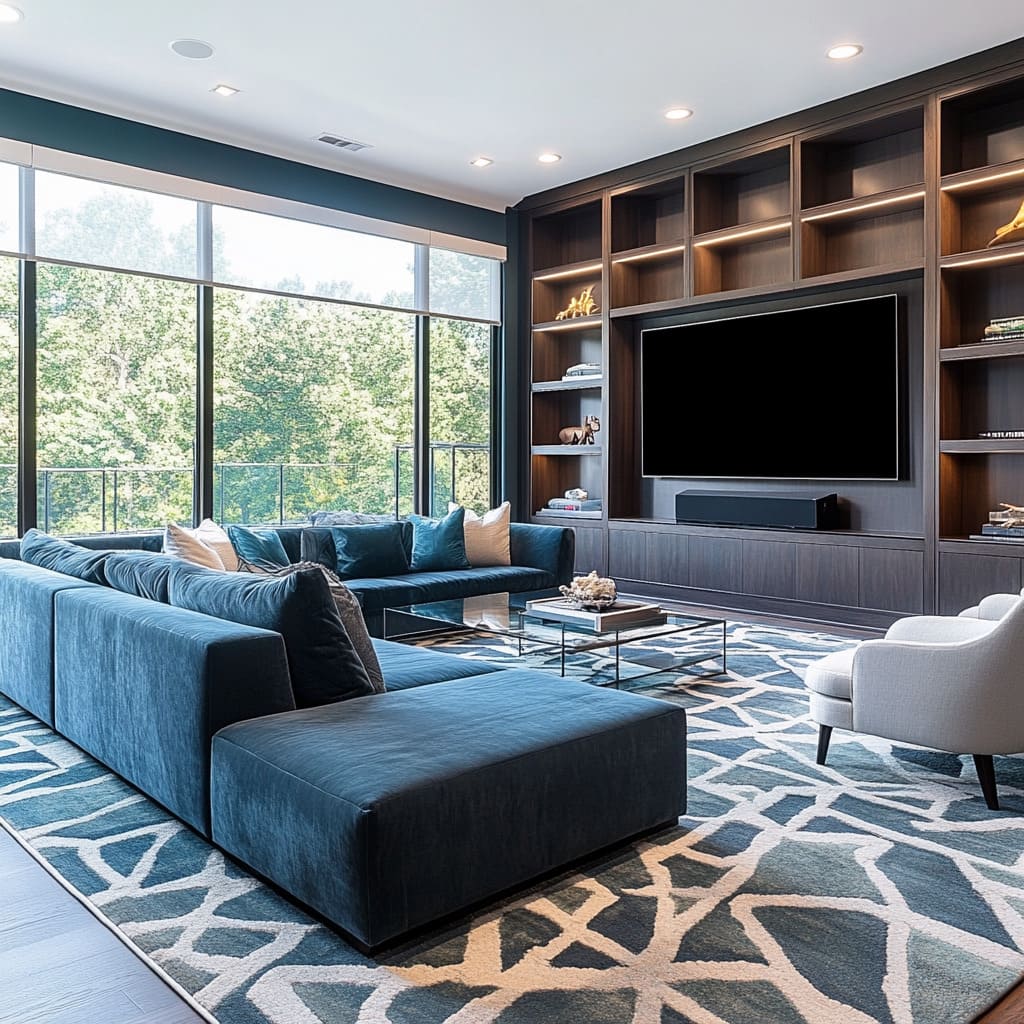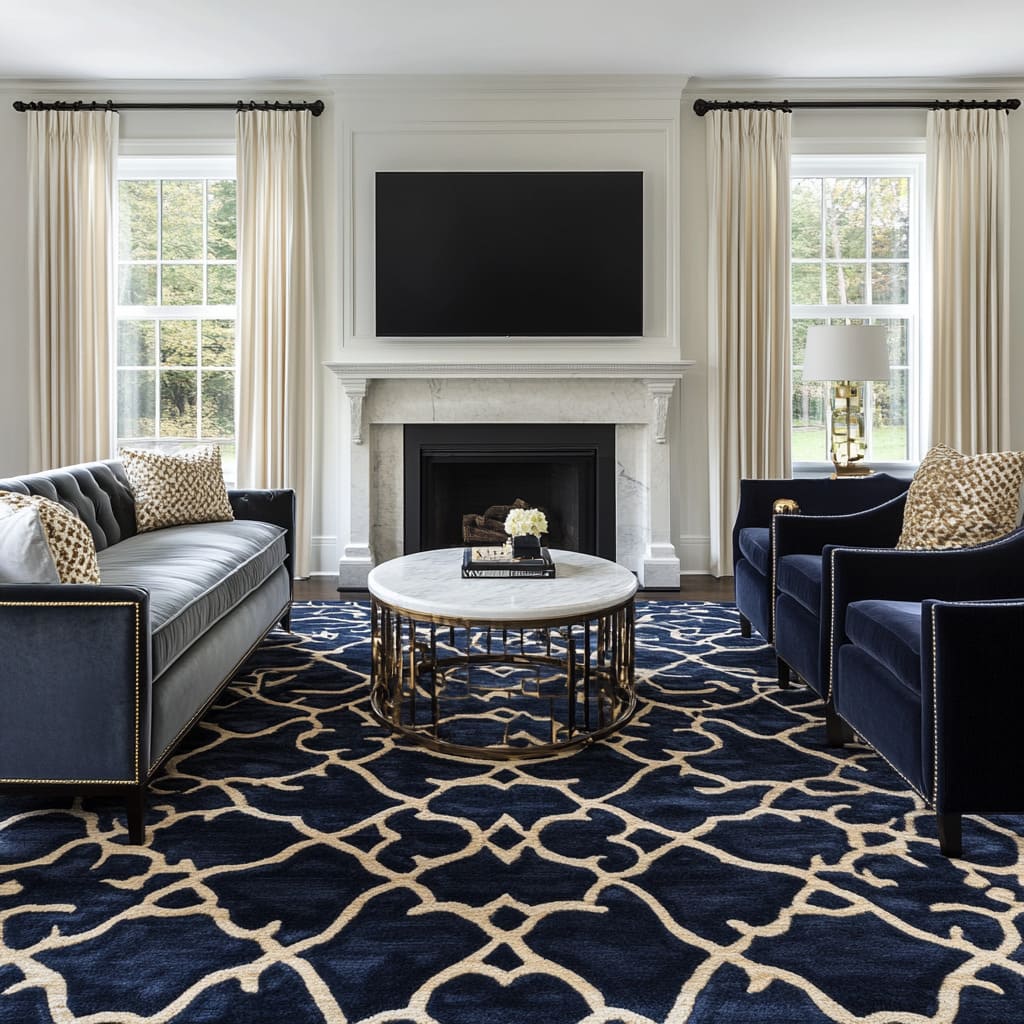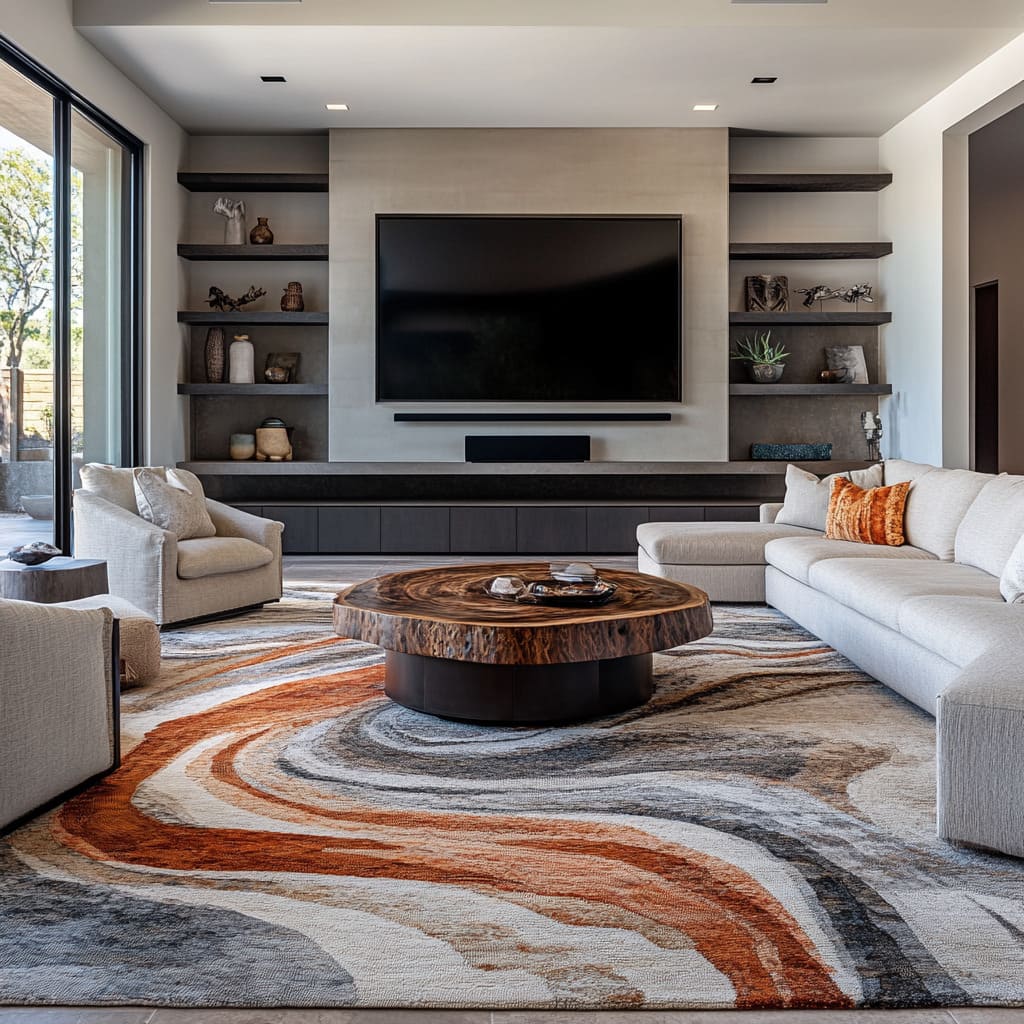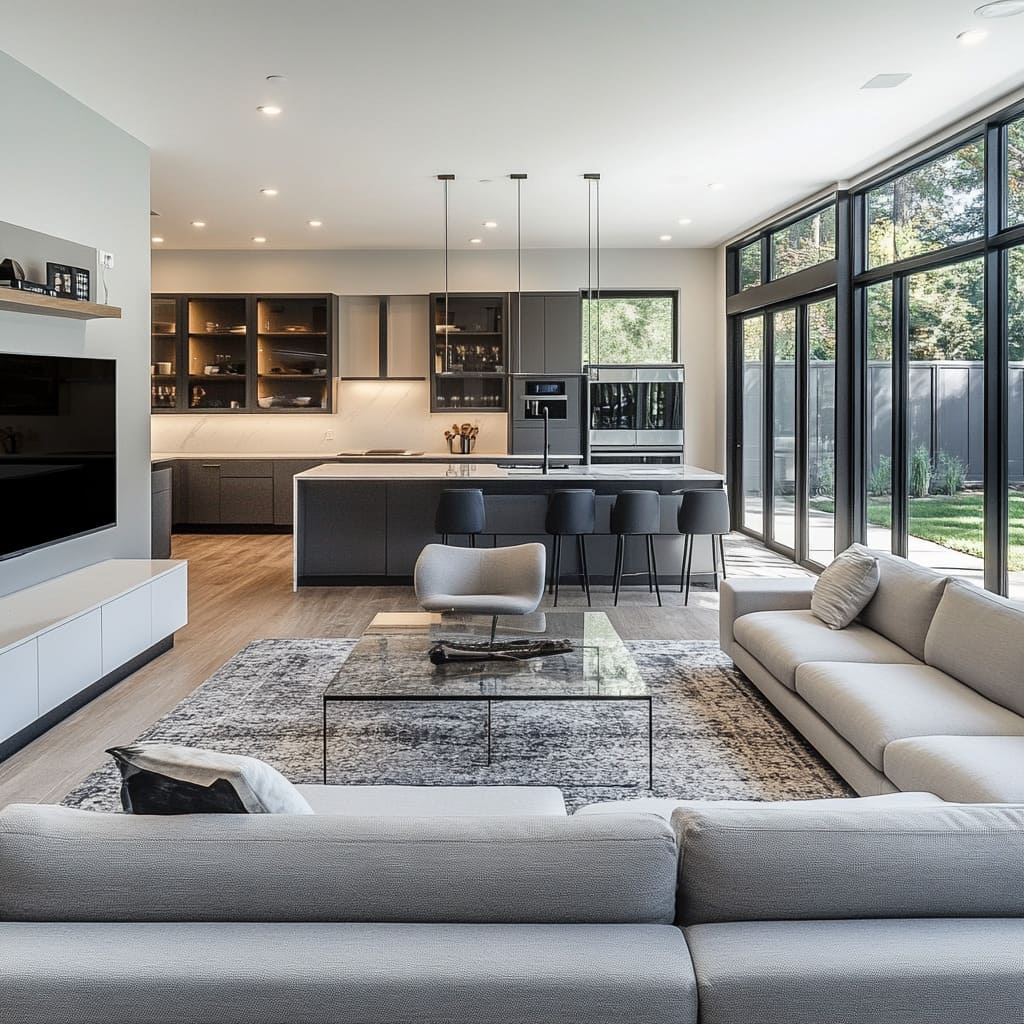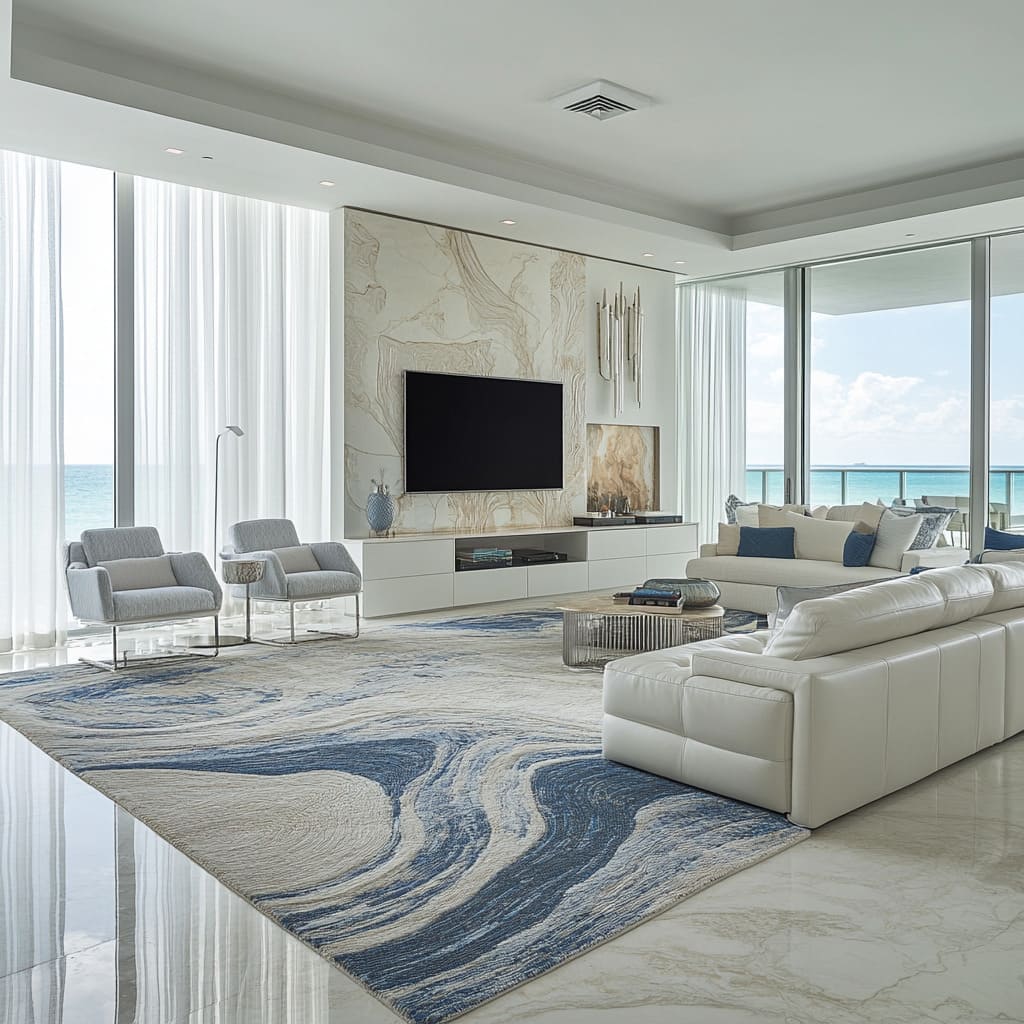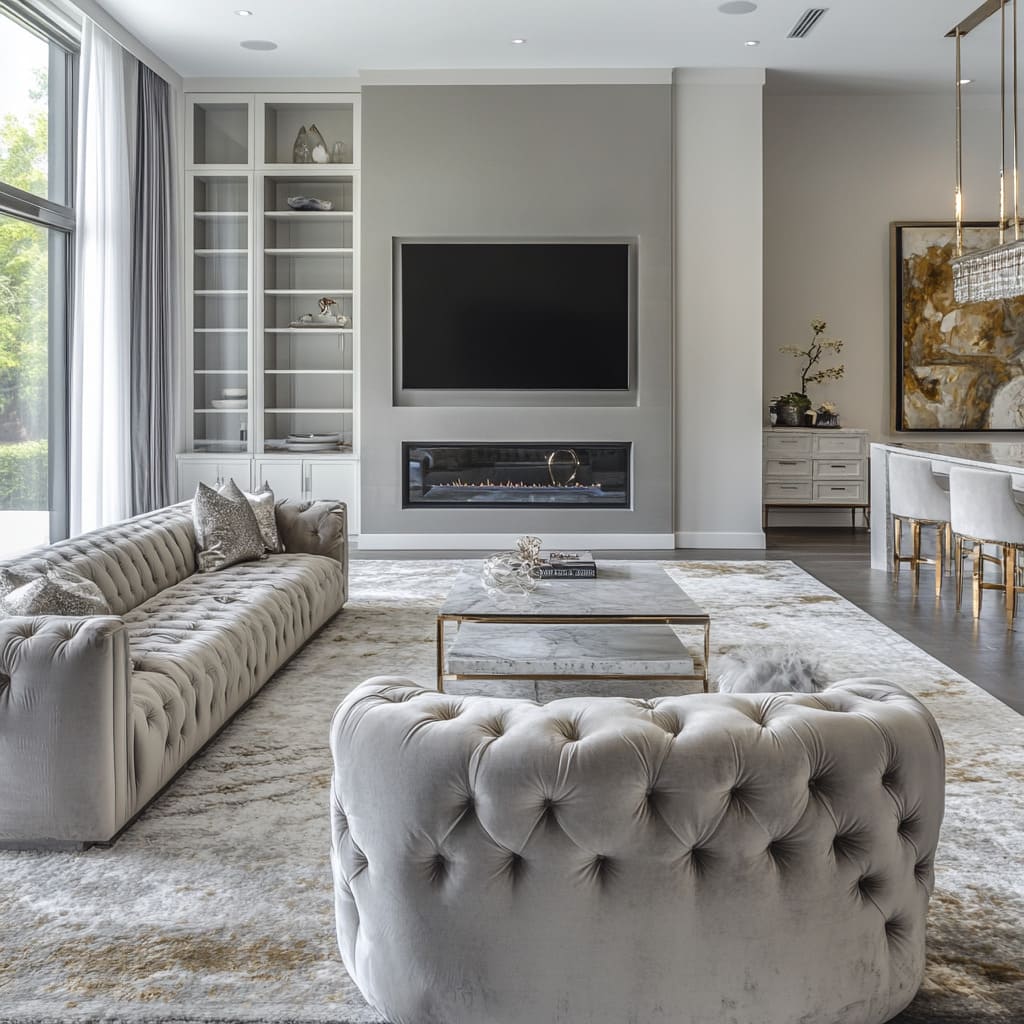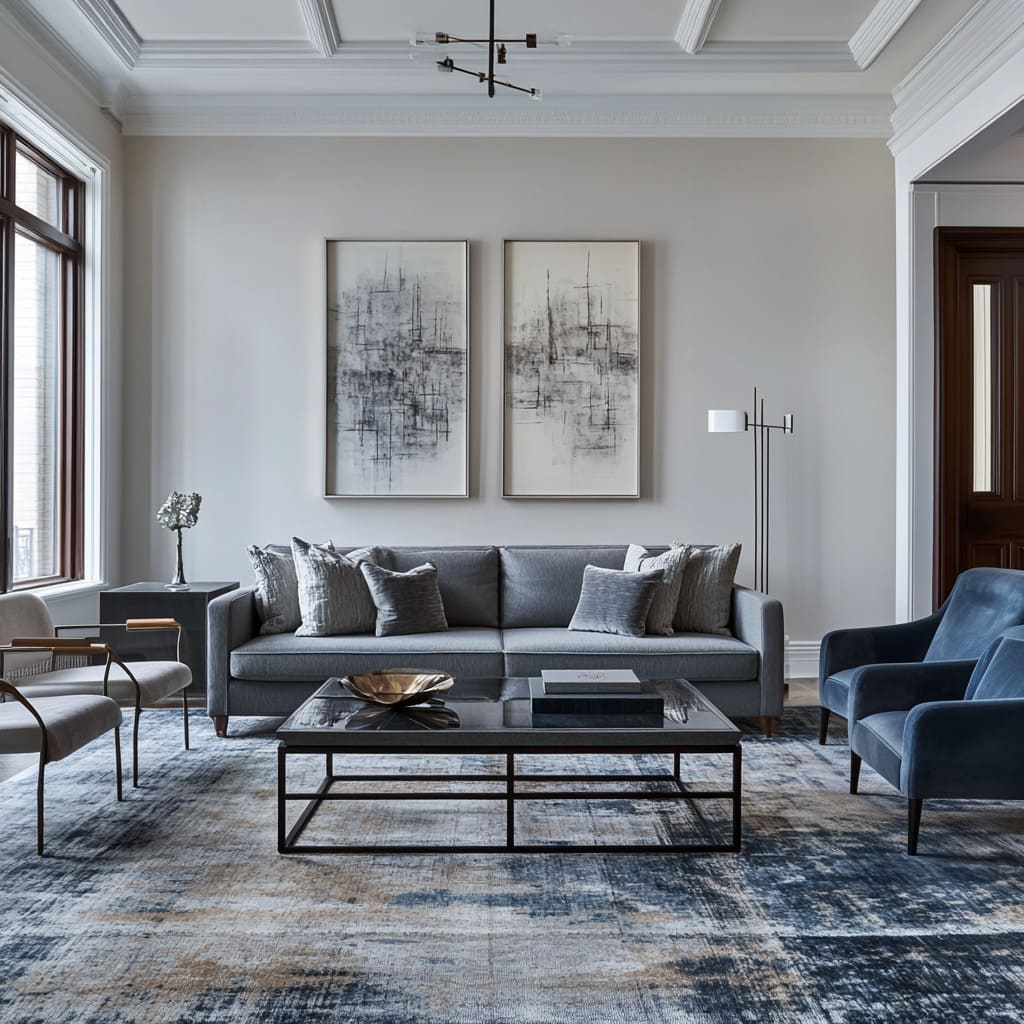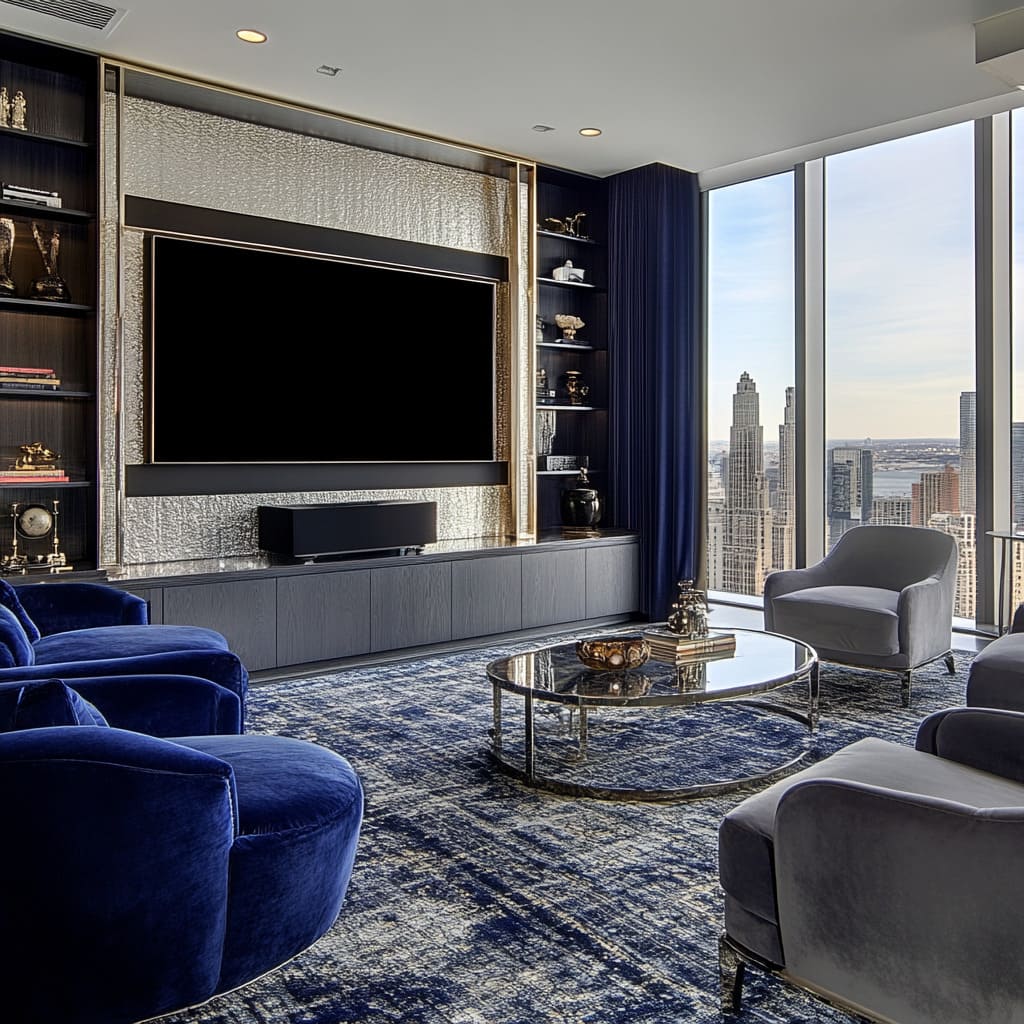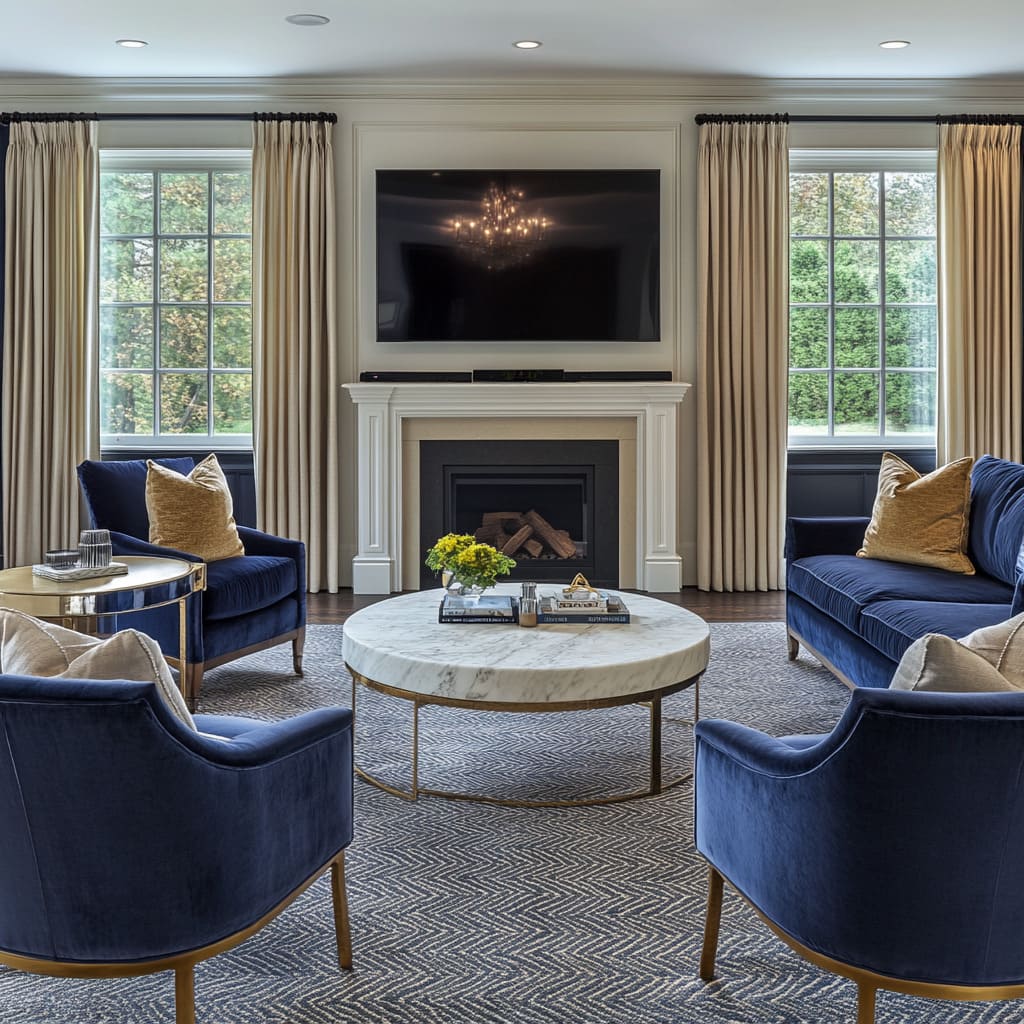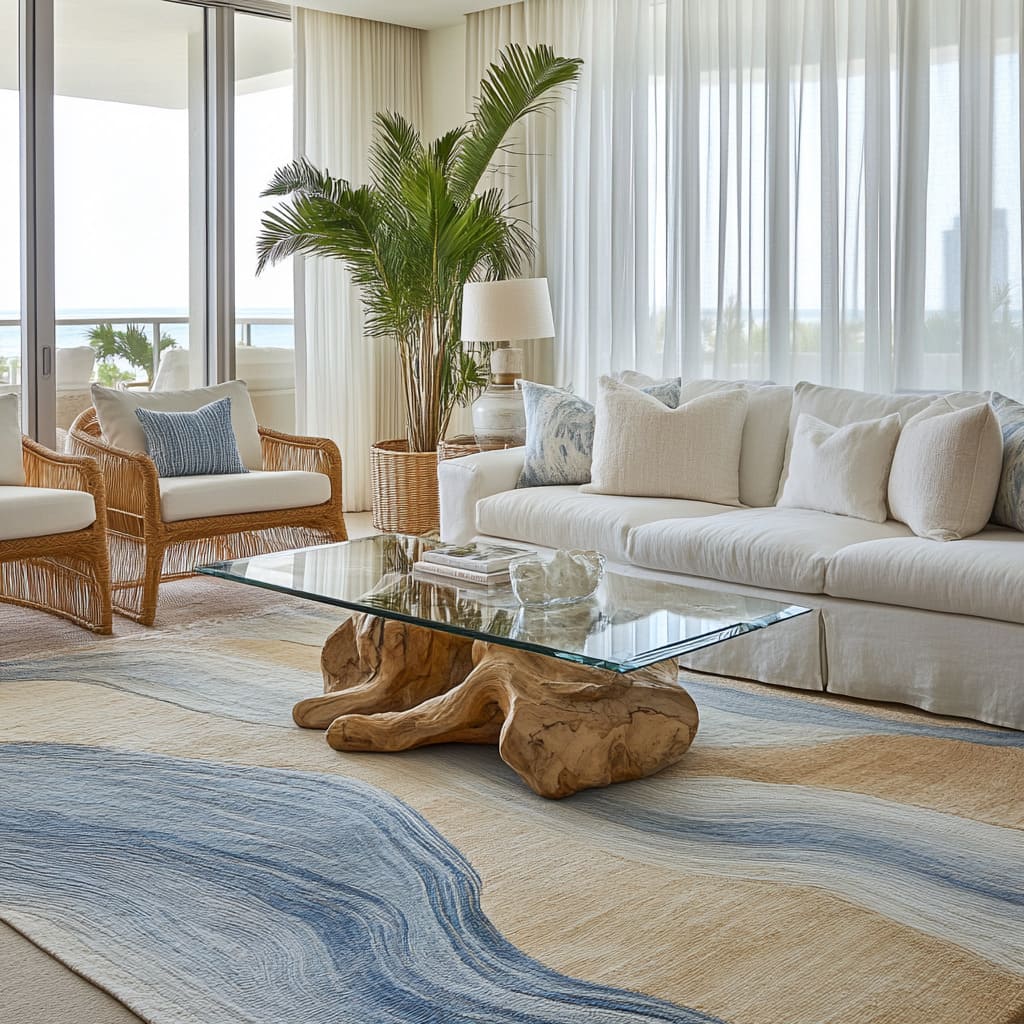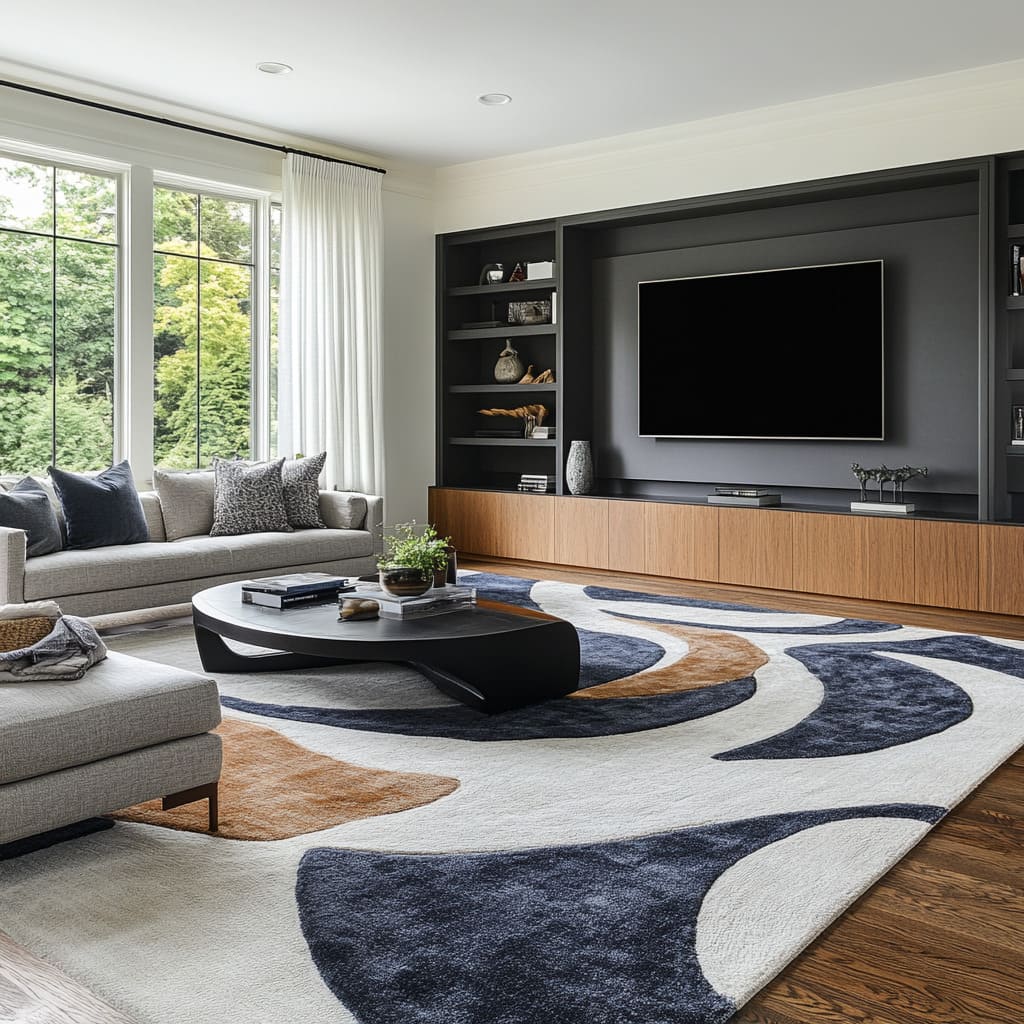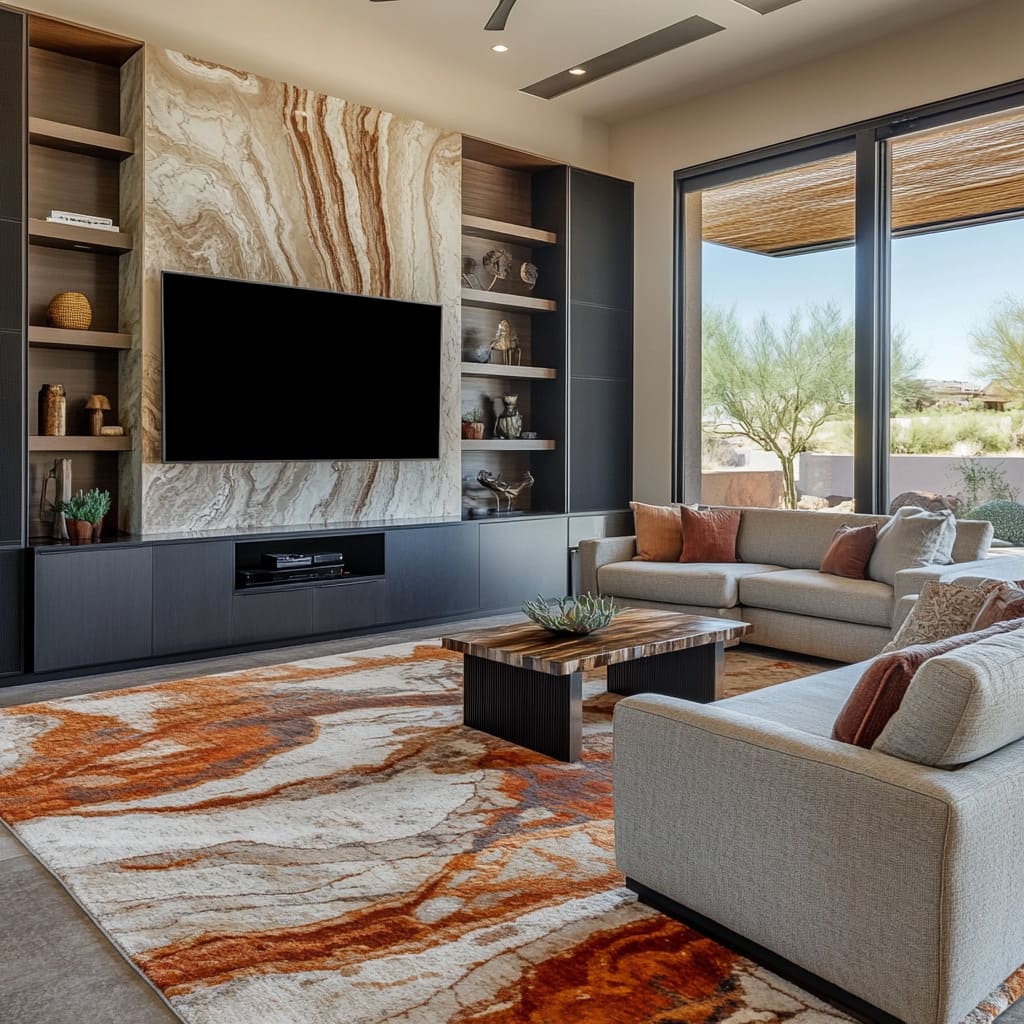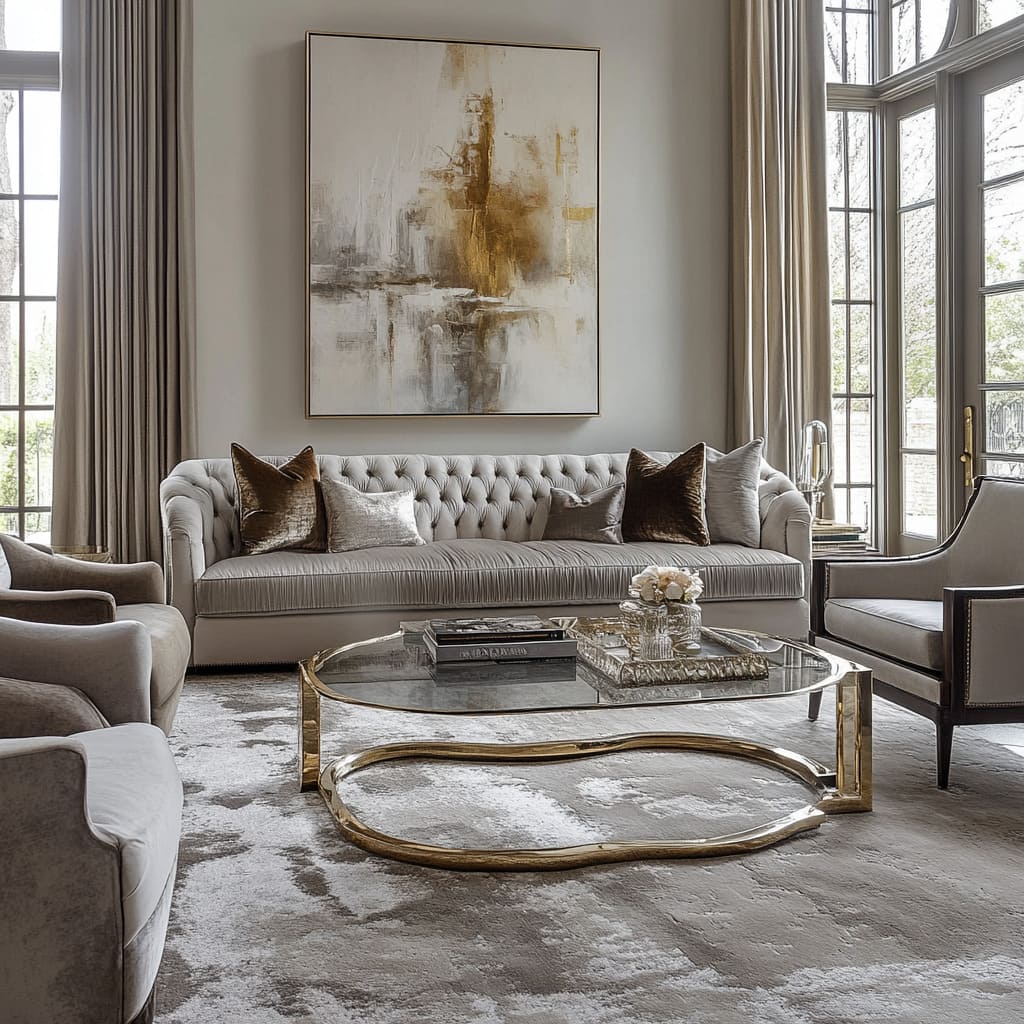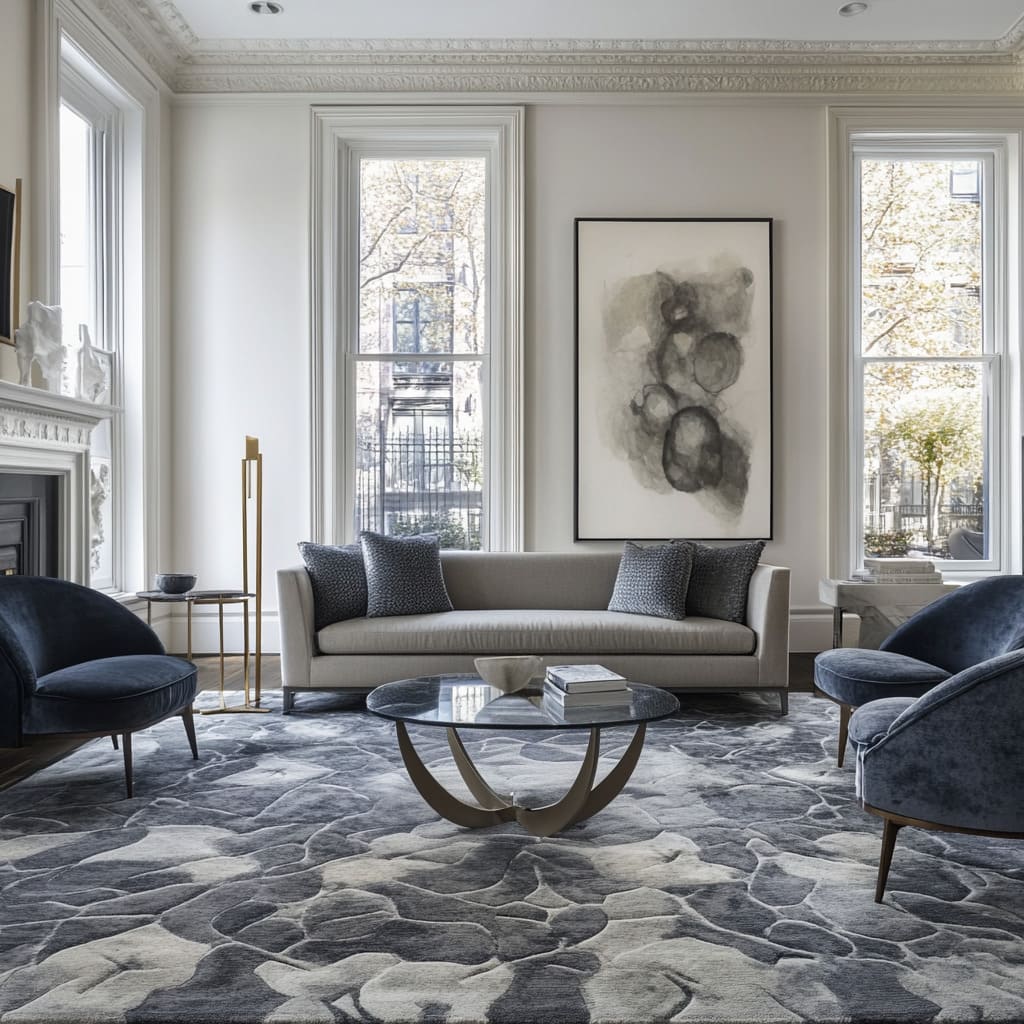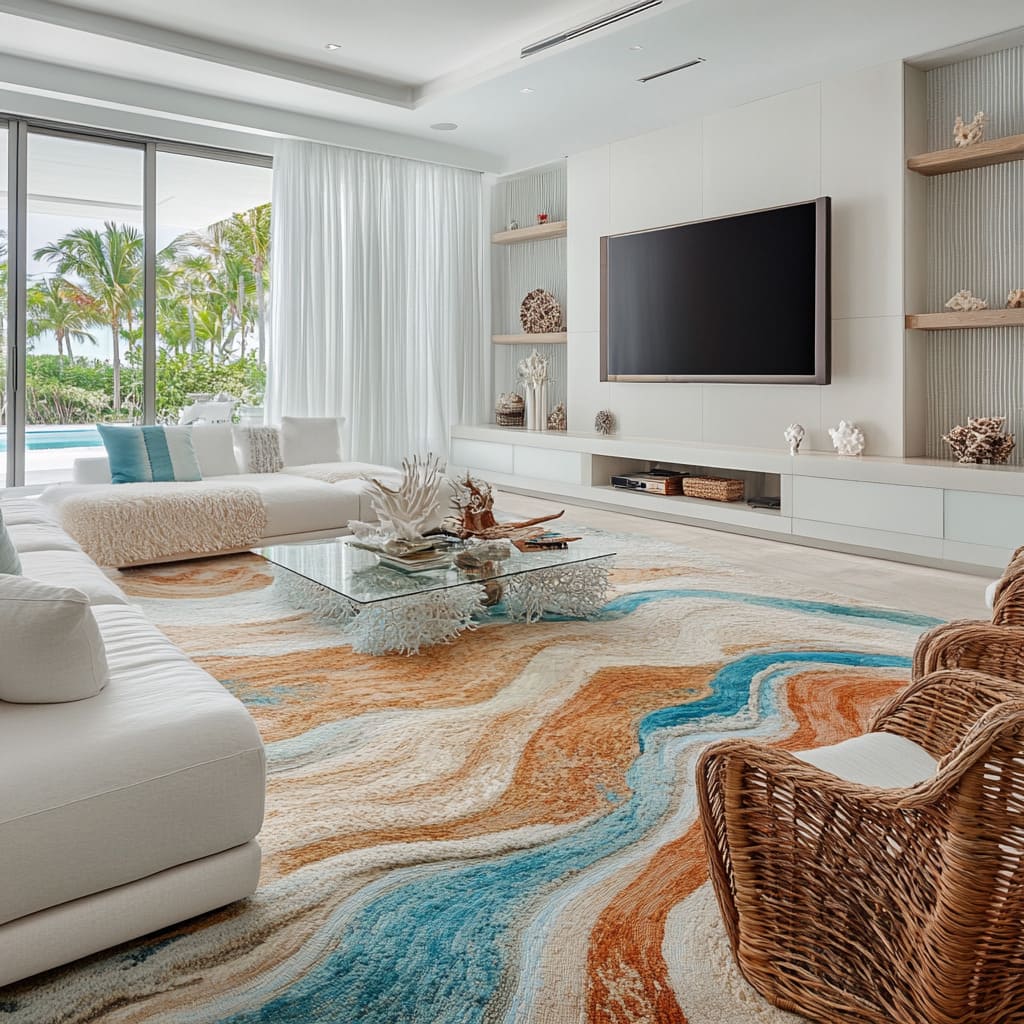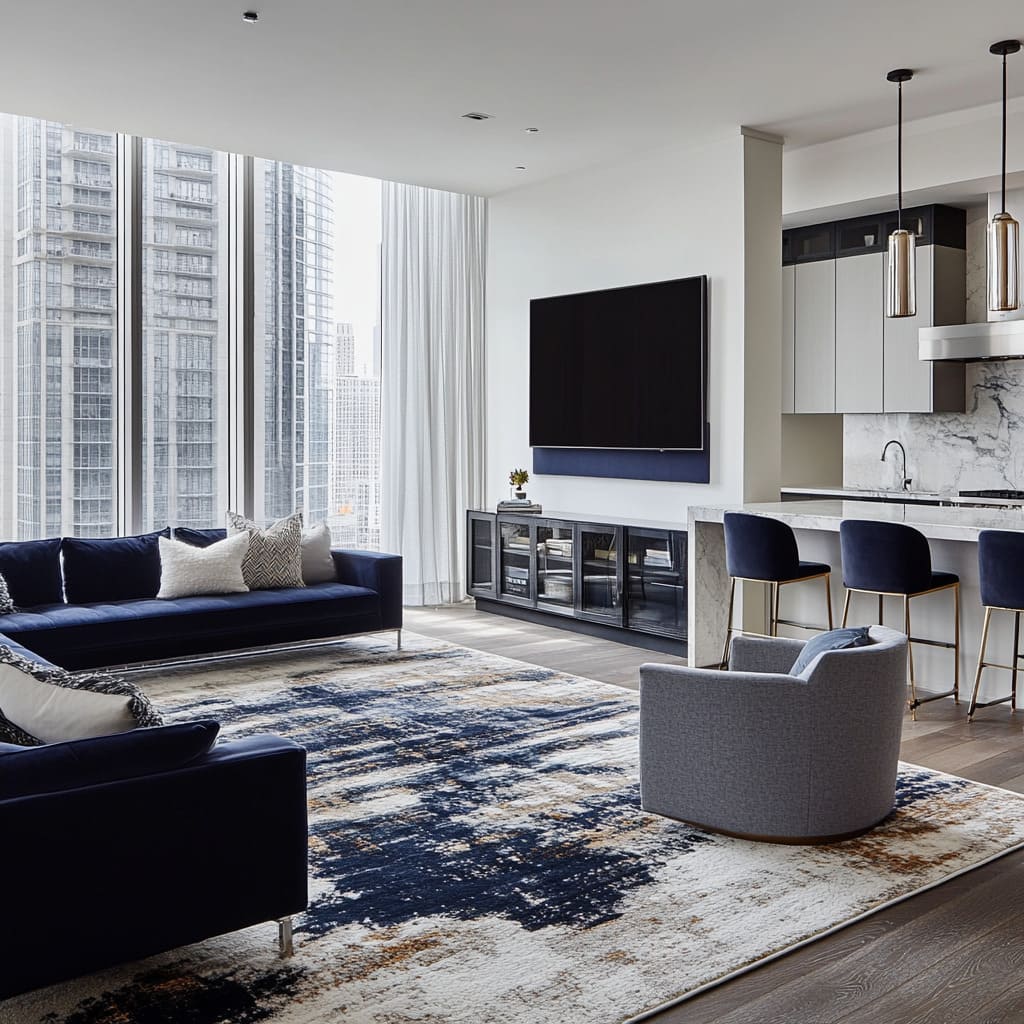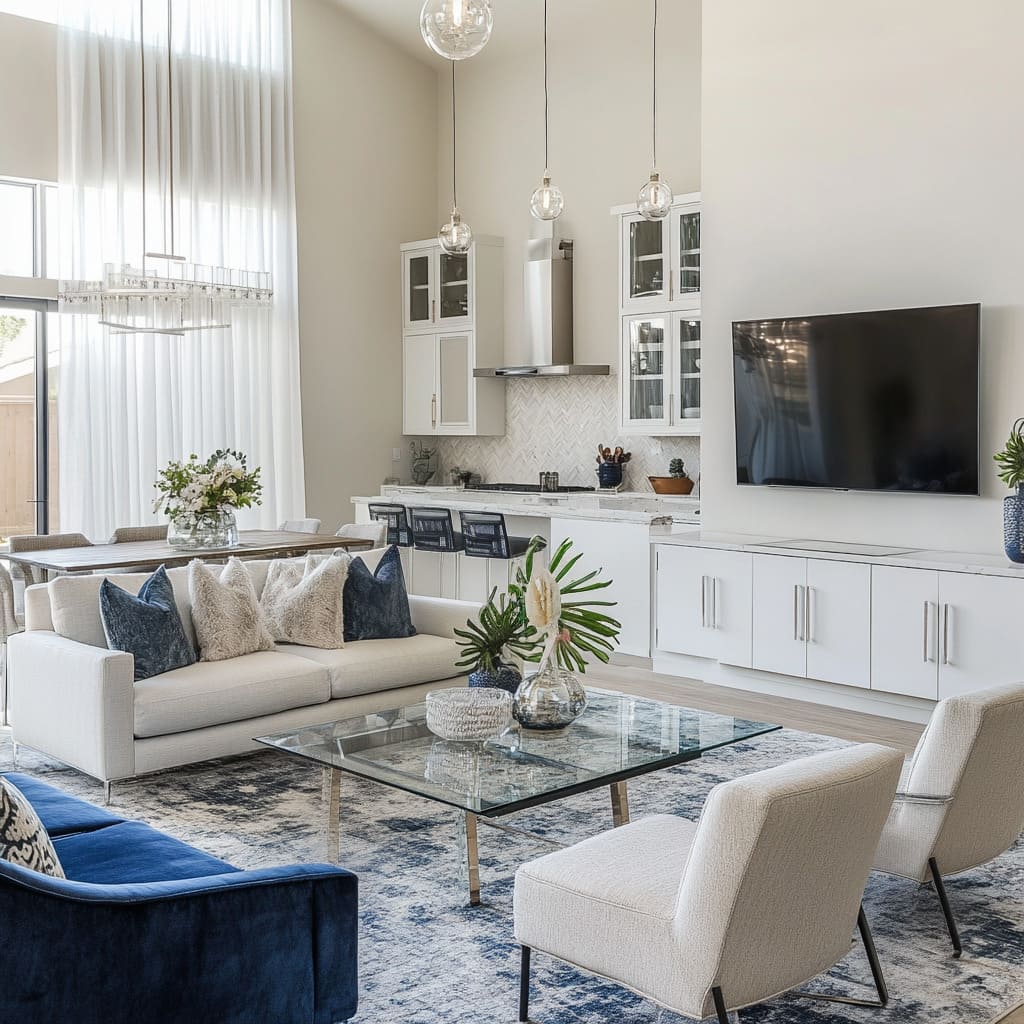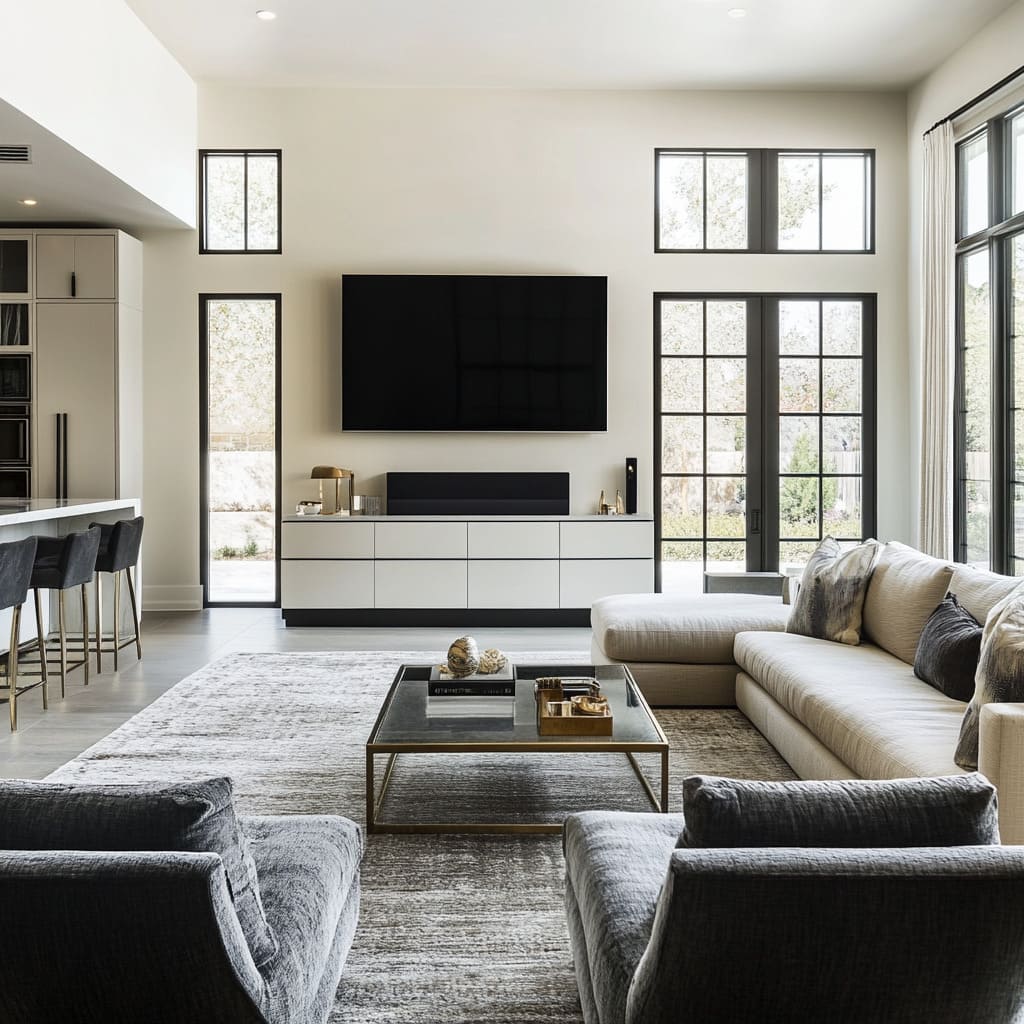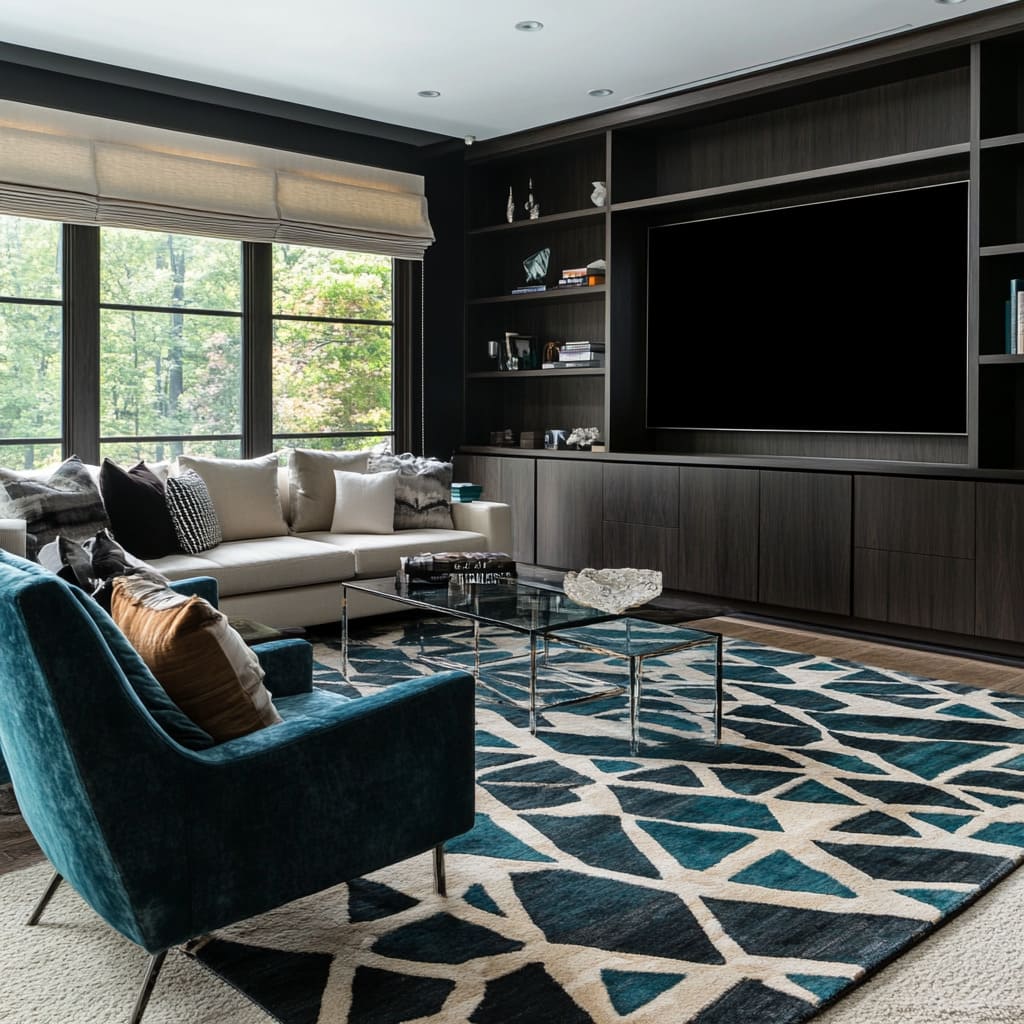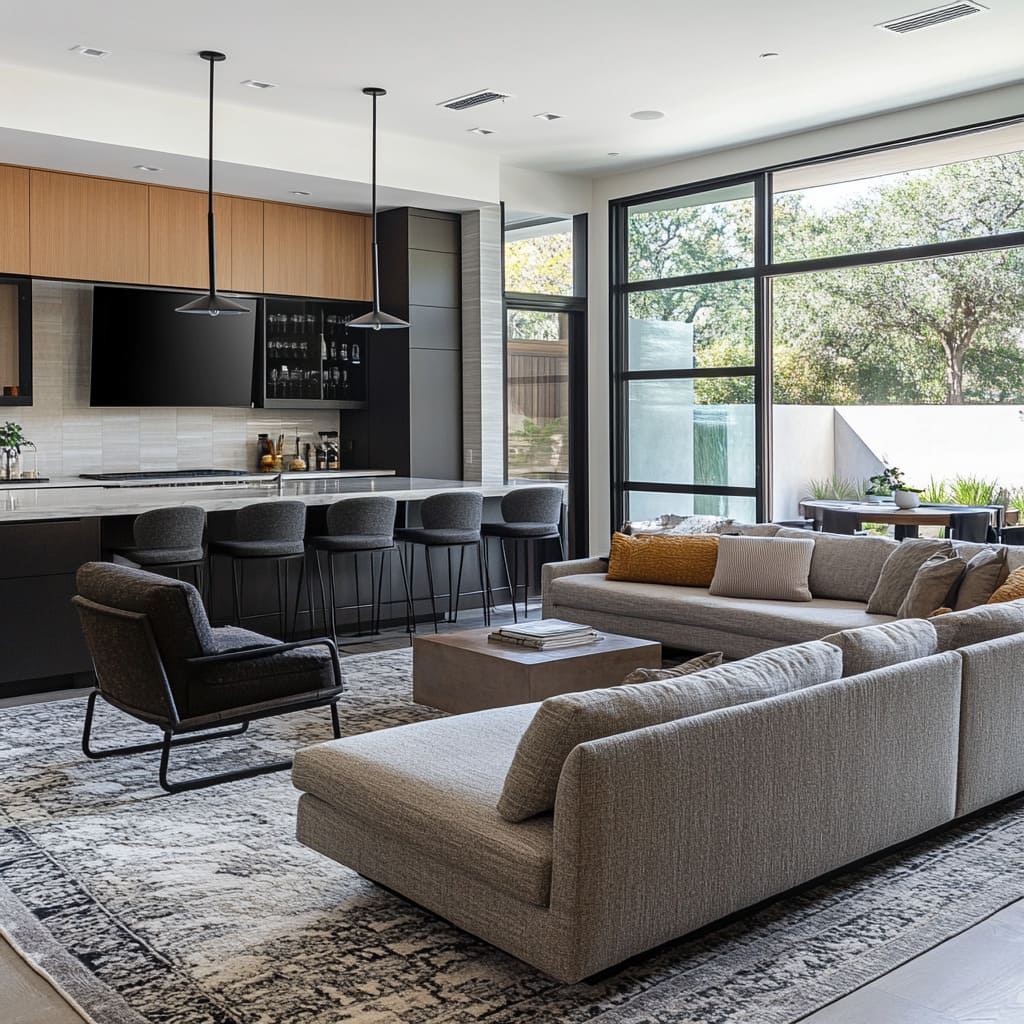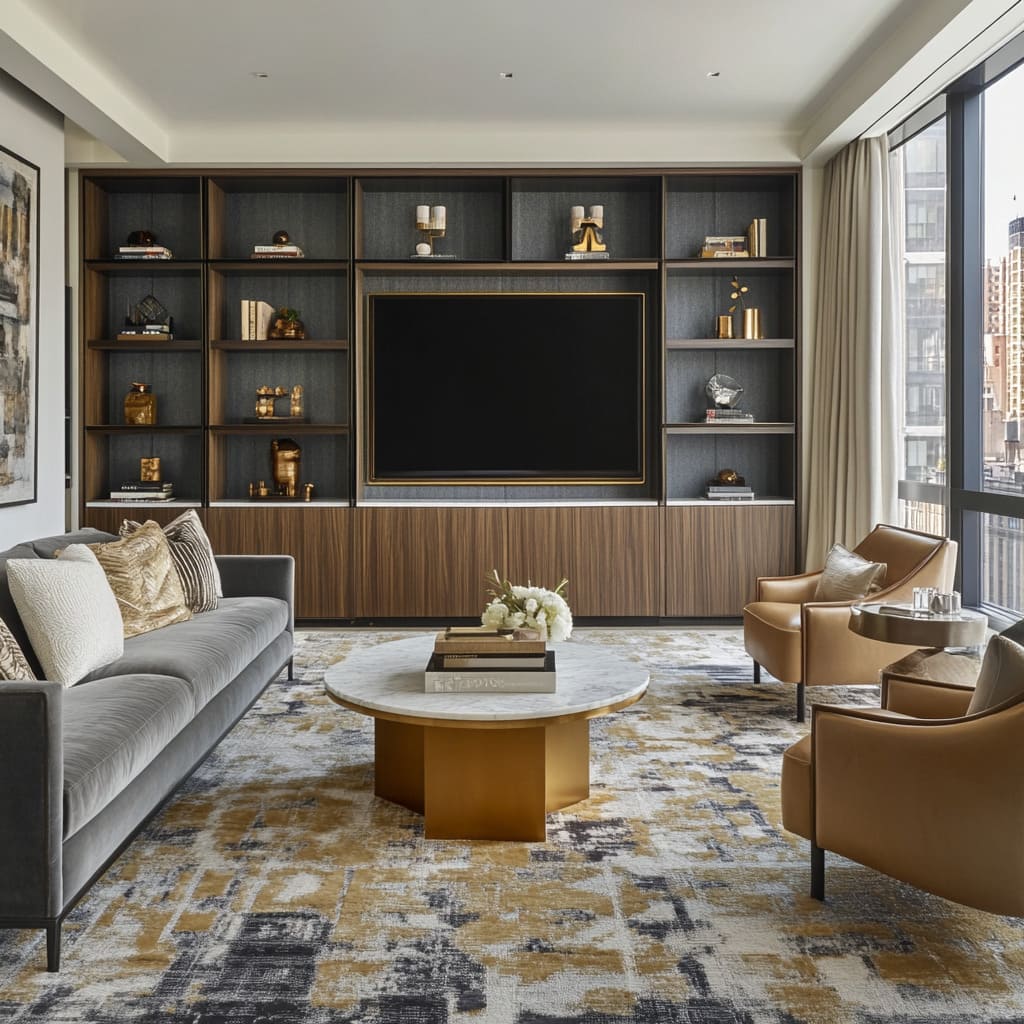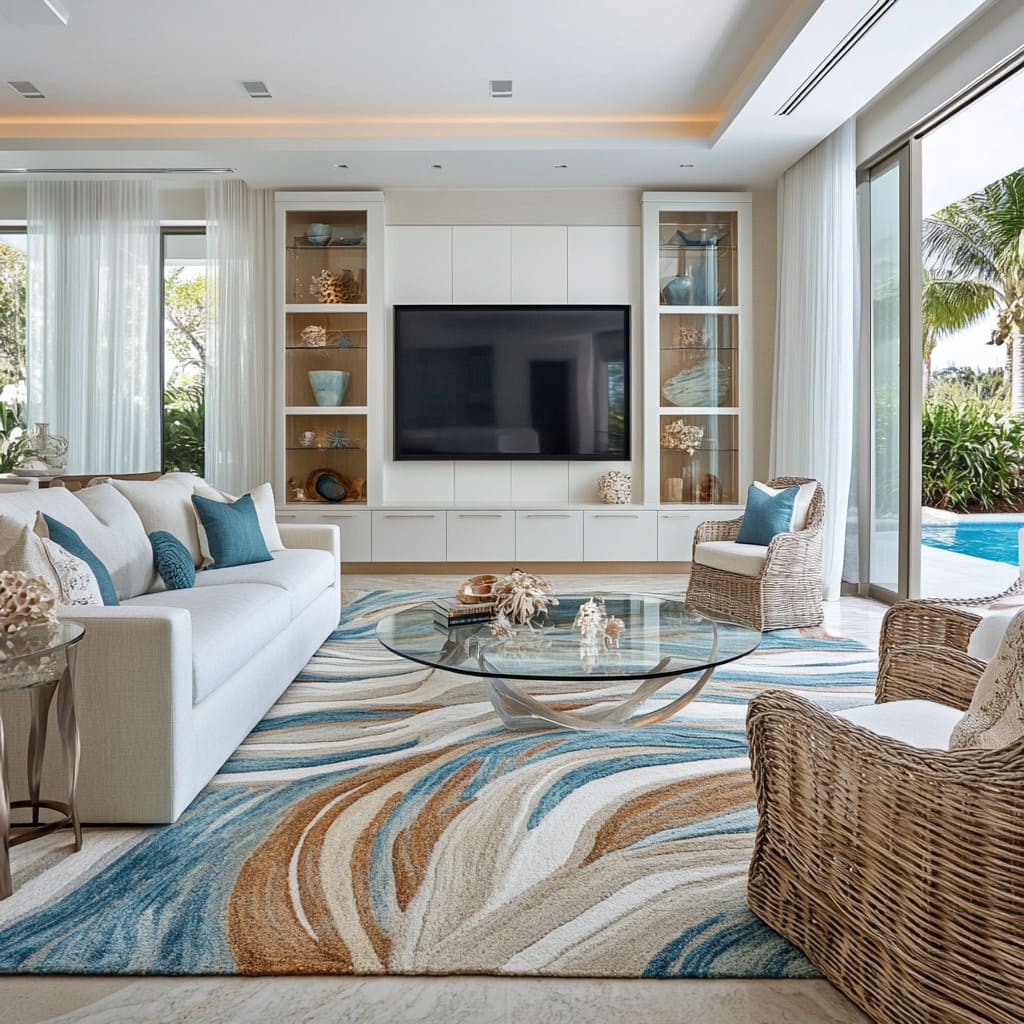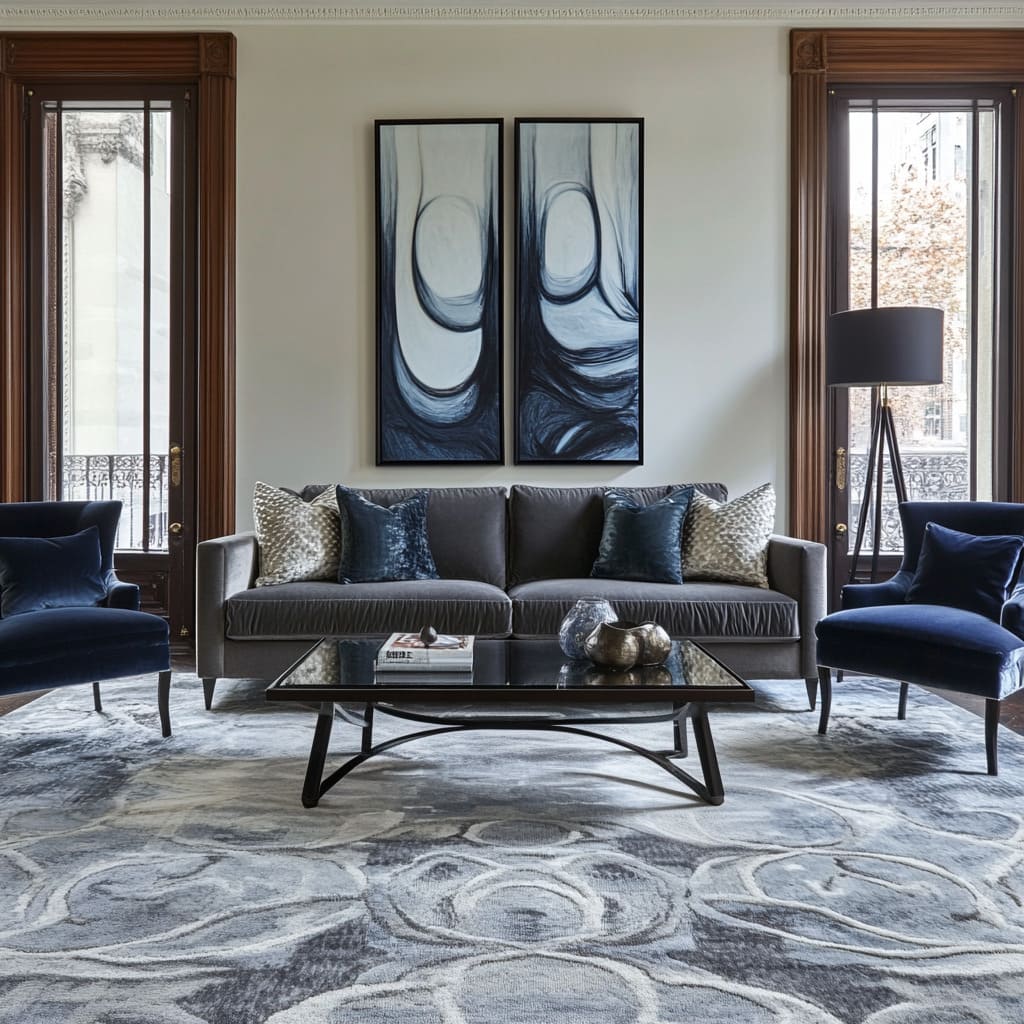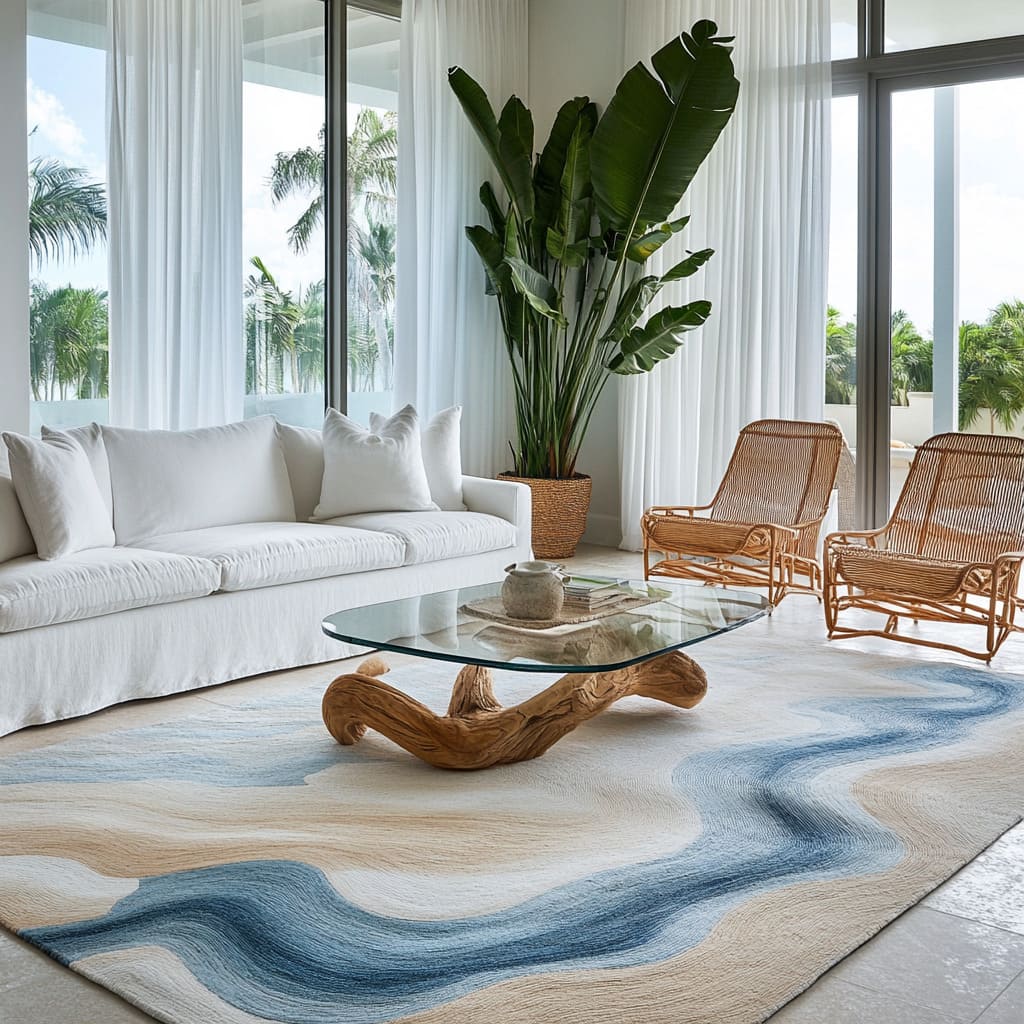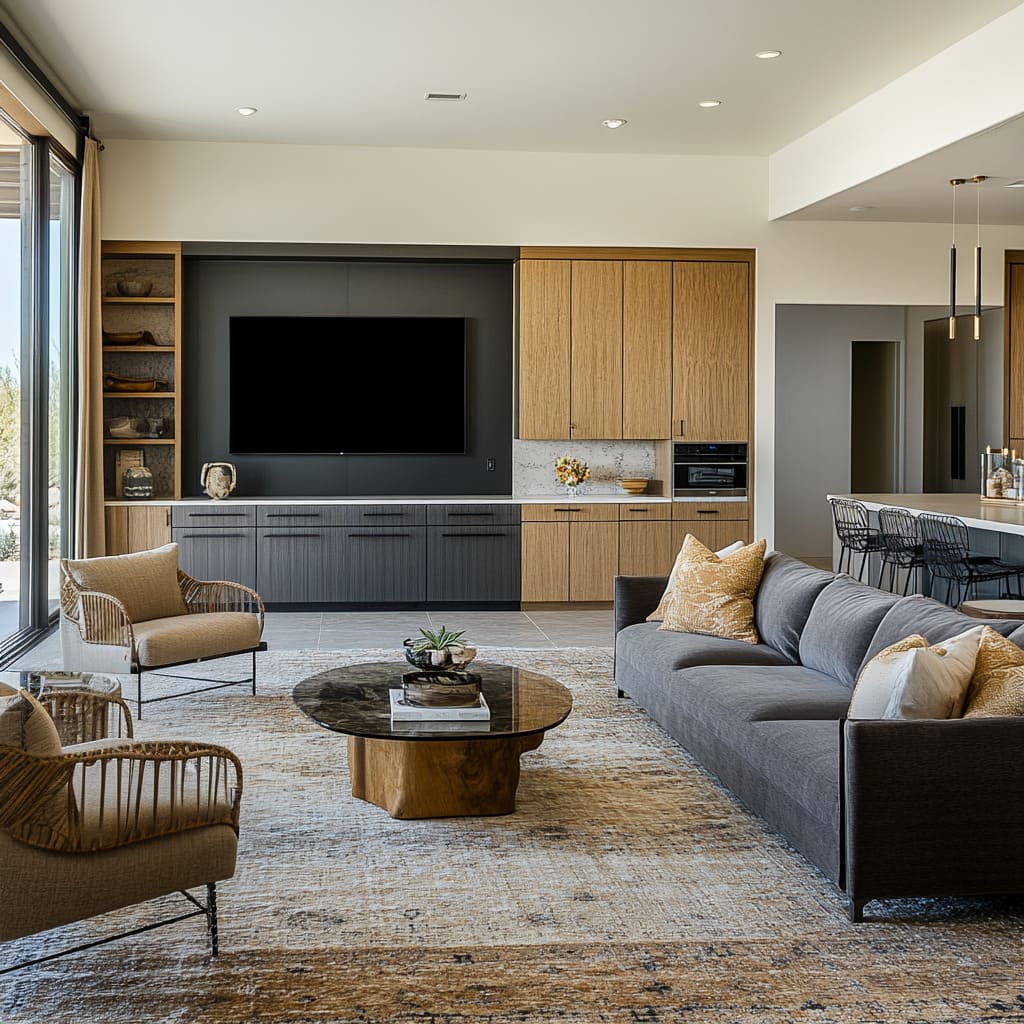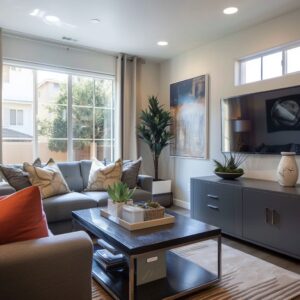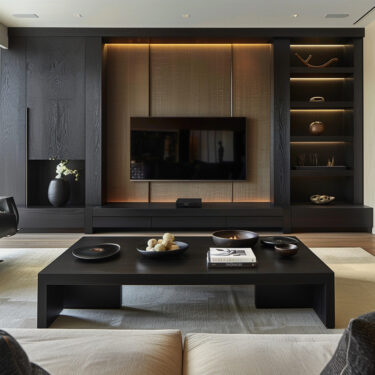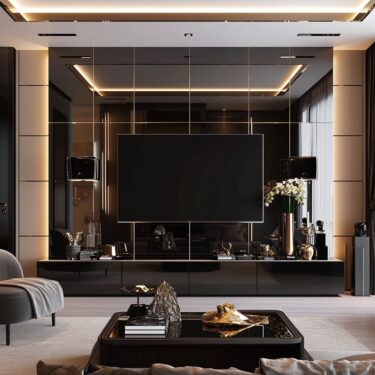Rugs hold a unique place in interior design, often serving as the finishing touch that brings a room together. Their ability to anchor a space, unify a color scheme, and add texture makes them an indispensable element in creating a stylish and cohesive home.
Whether you’re considering living room carpet ideas or looking to refresh a well-loved lounge, the right rug can be the key to transforming a space from ordinary to extraordinary.
Rugs don’t just lie beneath our feet; they ground the room, offering a sense of structure and harmony. They have the power to define areas within an open-plan layout, guiding the flow from one space to another.
Moreover, the texture and pattern of a rug can introduce layers of visual interest, adding depth to a room’s design. This article will explore why beautiful rugs are essential to stylish interiors, drawing on specific examples to illustrate their transformative impact.
The Foundation of Design: How Rugs Define Space
Anchoring the Furniture Layout
A rug is more than a decorative piece; it acts as the foundation upon which the rest of the room is built. In a large or open-plan living space, rugs help define seating areas, creating zones that bring order to the arrangement.
For instance, in a Miami Beach condo with an open-concept living room, a plush area rug under a sectional sofa not only anchors the furniture but also delineates the living area from adjacent spaces like the dining room or kitchen.
Choosing the right size rug is crucial in this context. A rug that’s too small can make a room feel disjointed, while one that’s too large might overwhelm the space.
Ideally, a rug should be large enough to fit all the front legs of the furniture on it, creating a cohesive and inviting seating area. This approach ensures that the rug feels integrated into the overall design, rather than an afterthought.
For those exploring living room area rug ideas, it’s essential to consider the room’s proportions. A well-chosen rug can make even the most expansive space feel intimate and well-connected, offering a solid base that ties all the elements of the room together.
Enhancing Architectural Features
Rugs also play a vital role in highlighting and enhancing the architectural features of a room. In spaces with high ceilings, expansive windows, or striking structural elements, a thoughtfully selected rug can balance these features by drawing the eye downward.
In a San Francisco loft, for example, the bold, patterned rug adds warmth and focus to the room, balancing the exposed brick walls and industrial beams with its vibrant design.
By introducing color, pattern, or texture at ground level, rugs can complement the room’s architecture without detracting from it. They add an element of comfort and style that works in harmony with the existing features.
When considering lounge carpet ideas, think about how a rug can enhance the room’s structural beauty, creating a sense of cohesion and balance.
Seamless Transitions in Open-Plan Layouts
Open-plan living spaces are increasingly popular for their versatility and flow, but they also present unique challenges in defining separate areas. Rugs offer a practical and stylish solution, creating distinct zones within a larger space while maintaining a sense of unity.
For instance, a loft or large apartment may feature an open living, dining, and kitchen area. A rug under the dining table can create a defined eating space, while another rug in the living area provides a cozy spot for lounging.
By carefully selecting complementary but distinct rugs, you can create smooth transitions between areas, each with its unique identity yet part of a cohesive whole.
When exploring rug ideas for living room setups, consider how different patterns, colors, or textures can work together to define spaces while still feeling part of a unified design. This approach allows for a harmonious blend of function and style, with each rug playing a key role in the overall aesthetic.
In conclusion, rugs are far more than just decorative items. They are integral to the design and functionality of a space, offering a way to anchor furniture, enhance architectural features, and create seamless transitions in open layouts.
By thoughtfully selecting and placing rugs, you can transform any room into a stylish, cohesive environment that reflects your taste and enhances your lifestyle.
A Canvas for Color: Using Rugs to Elevate Color Schemes
Rugs serve as more than just a functional element underfoot; they are often the very piece that can elevate a room’s aesthetic by acting as a canvas for color. Whether you’re introducing bold, vibrant hues or subtly enhancing a neutral palette, the right rug can transform the look and feel of a space.
Introducing Vibrant Hues
One of the most compelling aspects of choosing a rug is its ability to introduce color in a way that can be bold yet balanced. In rooms where the walls and furniture are kept neutral, a vibrant rug can inject energy and personality without overwhelming the space.
For example, consider a living room that features a predominantly neutral palette. An abstract rug with bold, vibrant colors—such as deep oranges, rich browns, and earthy grays—can bring a room to life by serving as a statement piece that draws the eye and anchors the color scheme.
In a modern Scottsdale home, an abstract rug with a striking pattern of burnt orange and muted grays perfectly complements the surrounding desert landscape. The rug not only adds a burst of color but also creates a warm and inviting atmosphere that reflects the natural beauty of the environment.
This kind of design approach demonstrates how rugs can serve as an integral part of a room’s color scheme, introducing bold hues that resonate with the room’s overall theme.
For spaces that are inspired by coastal environments, like a Miami Beach living room, rugs in shades of coastal blues and sandy tones can mirror the ocean and beach outside, seamlessly bringing the natural beauty indoors. The use of cool blues and soft beiges in the rug helps to create a serene atmosphere, tying together the indoor space with the natural colors of the surroundings.
Such modern living room rug ideas are perfect for those looking to infuse their spaces with both color and a sense of place.
Complementing Neutral Palettes
For many, a neutral color palette is the foundation of a chic and timeless space. However, without the right elements, such a palette can risk feeling flat or uninspired.
This is where a thoughtfully chosen rug can make all the difference, adding depth and texture that complements the neutral tones without overpowering them
In a San Francisco loft, for instance, the use of a soft gray and white rug with a subtle pattern introduces texture and complexity to the space, complementing the loft’s industrial elements while keeping the overall look cohesive. The rug’s design is understated yet sophisticated, providing a foundation that enhances the other elements in the room rather than competing with them.
This example underscores the importance of selecting a rug that not only fits within the existing color scheme but also enhances the room’s overall aesthetic.
Neutral rugs are particularly effective in creating a calm and inviting atmosphere, where the texture and subtle variations in color can add layers of visual interest. When considering rug ideas for small living room spaces, a neutral-toned rug can also help to create the illusion of more space, making the room feel larger and more open.
Creating Cohesion with Accent Colors
Rugs are also a powerful tool for tying together accent colors found throughout a room, creating a sense of cohesion and harmony in the design. Whether it’s the rust tones of throw pillows or the warm hues of a leather chair, a rug that incorporates these colors can unify the room’s palette, making the design feel intentional and complete.
In a Phoenix home, a rug with rich, earthy tones of rust, orange, and beige complements the accent pillows and decor, creating a warm and cohesive look. The rug doesn’t just sit underfoot; it pulls together the various elements of the room, making the space feel unified and thoughtfully designed.
This approach to using rugs can be particularly effective in open-plan spaces, where different areas need to feel connected yet distinct.
When exploring lounge rug ideas, consider how a rug can help to tie together the room’s existing colors, reinforcing the overall design. This is especially important in spaces where accent colors play a significant role in the decor.
By selecting a rug that incorporates these tones, you ensure that the room feels balanced and cohesive, with each element working in harmony to create a stylish space.
In conclusion, rugs are an essential tool in the designer’s arsenal for introducing and balancing color within a space. Whether used to make a bold statement, complement a neutral palette, or create cohesion with accent colors, the right rug can elevate the entire room’s design.
When considering modern living room area rug ideas, it’s clear that these pieces are not merely decorative; they are the canvas on which a stylish space is built.
Patterns and Personality: Making a Statement with Rugs
Rugs are not just floor coverings; they are essential design elements that bring personality and style into a room. When chosen thoughtfully, a rug can serve as the focal point of a space, introducing bold patterns that capture attention or subtle designs that add a touch of sophistication.
The patterns and textures of a rug can tell a story, reflect the homeowner’s taste, and set the tone for the entire room.
Bold Patterns as Focal Points
Bold, patterned rugs have the power to transform a room by becoming the visual anchor that draws the eye and adds personality. For instance, in a San Francisco loft, a rug with a cracked earth pattern serves as the centerpiece of the living space.
The intricate design of the rug contrasts beautifully with the industrial elements of the loft, such as exposed brick walls and metal beams. The rug’s pattern not only introduces a sense of movement and energy but also ties together the room’s various elements, making the space feel cohesive and intentionally designed.
When incorporating bold rug patterns into a room, it’s important to strike a balance with the surrounding decor. To avoid visual overload, pair a statement rug with simpler, more understated furniture and accessories.
For example, a bold geometric or abstract pattern can be balanced with solid-colored sofas and minimalistic decor, allowing the rug to shine without overwhelming the space. This approach is particularly effective in open-plan living areas, where the rug can serve as a defining element that separates the living area from other parts of the home.
Bold patterned rugs can be especially effective in small spaces, where they can inject life and character into the room without requiring much additional decor. When considering small living room carpet ideas, think of how a striking rug can make the space feel larger and more dynamic by drawing attention to the floor and creating a sense of depth.
Subtle Patterns for Sophisticated Style
Not all rugs need to make a bold statement to have a significant impact. Subtle, elegant patterns can bring a quiet sophistication to a room, adding layers of style without dominating the space.
These rugs work well in environments where the goal is to create a calm, cohesive atmosphere that invites relaxation and comfort.
In a Miami Beach condo, for example, a rug with soft, wave-like patterns complements the coastal theme of the space. The design is understated, yet it adds a fluidity and grace that echoes the nearby ocean.
This type of rug is perfect for those who want to introduce pattern into a room without overwhelming the senses. The soft hues and gentle curves of the rug create a serene foundation, upon which the rest of the room’s decor can be built.
Subtle patterns are also ideal for rooms that feature bold architectural elements or colorful artwork. A rug with a delicate design can enhance these features by providing a complementary backdrop that ties the room together.
When exploring modern living room carpet ideas, consider how a subtle patterned rug can elevate the space by adding depth and interest in a refined manner.
These subtle designs are also versatile, working well in both large and small spaces. For instance, a small living room can benefit from a subtly patterned rug that adds texture and interest without making the space feel cluttered or busy.
This approach allows the room to feel open and inviting, with the rug quietly enhancing the overall design.
In summary, whether you opt for bold patterns or subtle designs, the right rug can define the personality of a room. By thoughtfully selecting a rug that aligns with your design goals, you can create a space that is both stylish and reflective of your unique taste.
Function Meets Style: Practical Considerations for Choosing Rugs
When selecting a rug, it’s not just about aesthetics; practicality plays a crucial role as well. The best rugs balance function and style, ensuring that they not only enhance the look of a room but also stand up to the demands of everyday life.
Here’s how to choose a rug that excels in durability, comfort, and acoustic benefits while maintaining its stylish appeal.
Durability and Maintenance
In high-traffic areas like living rooms, durability is a key factor in choosing the right rug. A rug that wears out quickly can detract from the room’s overall look and feel, so it’s important to select materials and construction methods that are built to last.
Wool is a popular choice for its natural resilience, easy maintenance, and ability to withstand heavy use without losing its shape or appearance. Synthetic fibers like nylon and polypropylene are also good options for areas that see a lot of foot traffic, as they are both durable and stain-resistant.
For those considering living room carpet ideas, think about how the rug will be used on a daily basis. Will it be in a busy family room where kids play and pets lounge? Or is it in a more formal space where it won’t see as much wear and tear? Understanding the use of the room can help guide you to a rug that is both practical and stylish.
Additionally, consider a rug with a low pile for easier cleaning and less wear, or opt for a patterned rug that can hide the occasional stain or dirt. Rugs made from wool or durable synthetics offer excellent resilience, but regular upkeep is equally important to maintain their appeal.
Regular maintenance is also important to extend the life of your rug. Vacuuming regularly, rotating the rug to even out wear, and addressing spills immediately can all help keep your rug looking its best for years to come.
Investing in a high-quality rug pad can also protect the rug from friction and slippage, adding an extra layer of durability
Comfort and Warmth
Rugs do more than just add visual appeal; they also contribute significantly to the comfort and warmth of a room. A thick, plush rug can make a living space feel cozy and inviting, offering a soft surface underfoot that enhances the overall comfort of the room.
In cooler climates or rooms with hard flooring, a rug can also serve as an insulating layer, helping to keep the space warm and comfortable.
Consider the comfort that comes with a well-chosen rug when exploring rug ideas for living room designs. A thick pile or a soft material like wool or shag can create a welcoming environment, making it perfect for spaces where people gather to relax, such as in front of a fireplace or a cozy sitting area.
The tactile quality of a plush rug can also add to the sensory experience of a room, making it a place where people naturally gravitate to sit or lie down.
For modern living room rug ideas that prioritize comfort, look for rugs that offer a balance of softness and durability. Wool rugs, for example, are not only durable but also naturally soft and warm, making them a popular choice for living rooms that need both style and comfort.
Layering a smaller, plush rug over a larger, flat-woven one can also add depth and softness, enhancing the room’s cozy feel.
Noise Reduction and Acoustics
Rugs play a crucial role in improving the acoustics of a room, particularly in large or open spaces with hard surfaces. Hard floors and high ceilings can create echoes and amplify sounds, making the environment feel cold or uninviting.
By adding a rug, you can significantly reduce noise levels and create a more comfortable and intimate atmosphere.
When placed strategically, rugs can absorb sound, reducing echo and footstep noise, which is especially important in spaces with minimal furniture or open layouts. For instance, in a living room with hardwood floors and high ceilings, a well-placed rug can soften the acoustics, making conversations clearer and reducing overall noise.
This consideration is particularly valuable for homes in urban environments or in apartment buildings where noise control is essential.
When looking into living room area rug ideas, consider how the rug’s material and thickness can influence the room’s acoustics. Thicker rugs with dense fibers will generally provide better sound absorption than thinner, flat-woven options.
For rooms that are used for entertainment, such as media rooms or spaces with high ceilings, the acoustic benefits of a well-chosen rug can make a noticeable difference in the room’s comfort and usability.
Conclusion
Choosing the right rug is about more than just finding a design that looks good. A great rug should also meet the practical needs of the space, from standing up to daily use to adding comfort and warmth, and even improving the room’s acoustics.
By considering durability, comfort, and noise reduction alongside style, you can find a rug that truly enhances your living space, making it both functional and beautiful.

